This post assumes an understanding of Star Trek Attack Wing (STAW). Read a brief introduction to it here.
Last month I attended the Chronological Chaos OP at our Friendly Local Game Store (FLGS.) The FLGS I play at plays Faction Pure. We were also playing “old rules.” So, no subfactions. Two of my sons also attended. I played the Independent Faction. My older son played Romulan. But, it was the Federation Fleet that my younger son ran that was the unbeatable build.
It’s obviously pretty bold to call a build unbeatable, especially when you are limiting the build to a single faction. I’ll go over the build and then walk through the first Activation (movement) Phase. I think it would be difficult to prevent that first move and it would be nearly impossible to catch him after the first turn.

Chronological Chaos OP
In this scenario, your fleet arrives in an unexplored sector of space to investigate a series of subspace anomalies causing large scale time fluctuations across the quadrant. As you arrive, your sensors detect an enemy fleet coming out of warp nearby. You have direct orders to investigate the anomalies to figure out their source, but you cannot simply ignore your most hated enemies while doing so. As you engage in combat and start investigating these anomalies, you realize that they are tears in space and time which bridge multiple universes!
Essentially, you have to fly to each of four spots in the playing area as quickly as possible, without having your fleet destroyed. Chronological Chaos has multiple victory conditions.
- Any ship has four mission tokens at the end of the round. (Meaning it has visited each of the four objectives)
- One player is eliminated.
- The time limit is reached.
That means that the game is over if someone gets to all four spots, or if one fleet destroys their opponent’s fleet, or if the players take an hour and neither player has eliminated the other or made it to all four spots We built the Federation Fleet specifically to accomplish goal #1. We were not interested in fighting. In fact, because only ships who have gone through the same number of checkpoints can attack each other, the goal was to prevent the opponents from even being able to interact with “the Rabbit,” our fastest ship.
The Rabbit Build
U.S.S. Raven [U.S.S. Raven] (16) <– The Rabbit
Jean-Luc Picard [U.S.S. Stargazer] (4)
Adm Maxwell Forrest [Enterprise NX-01] (3)
Picard Maneuver [U.S.S. Stargazer] (5)
William T. Riker [U.S.S. Enterprise-E] (5)
Phlox [Enterprise NX-01] (2)
Pavel Chekov [U.S.S. Reliant] (3)
Transwarp Drive [U.S.S. Excelsior] (3)
Total (41)
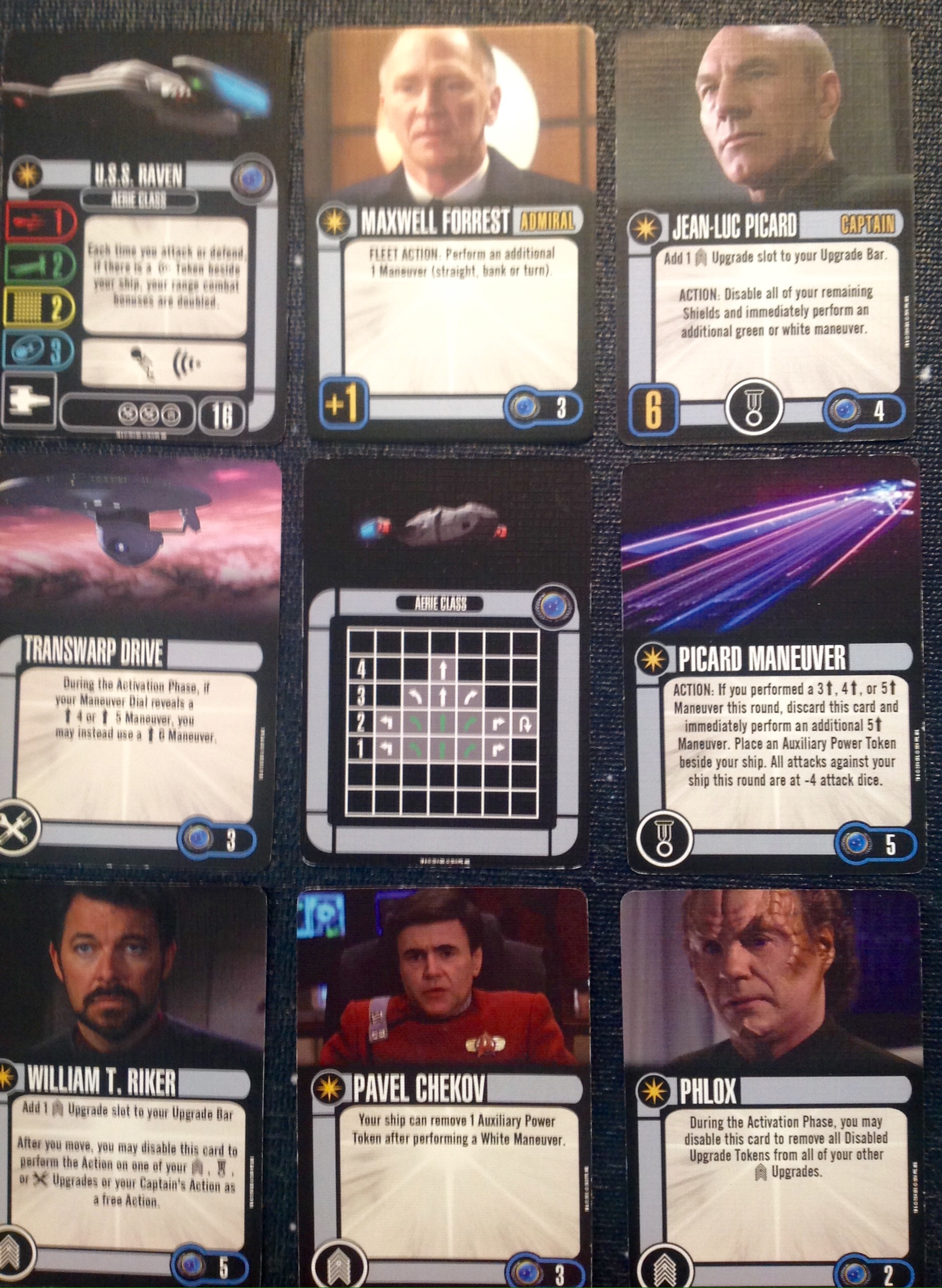
Prometheus Class [U.S.S. Prometheus] (28)
Benjamin Maxwell [U.S.S. Yeager] (4)
Defy Orders [U.S.S. Lakota] (4)
Automated Distress Beacon [U.S.S. Constellation] (3)
Total (39)
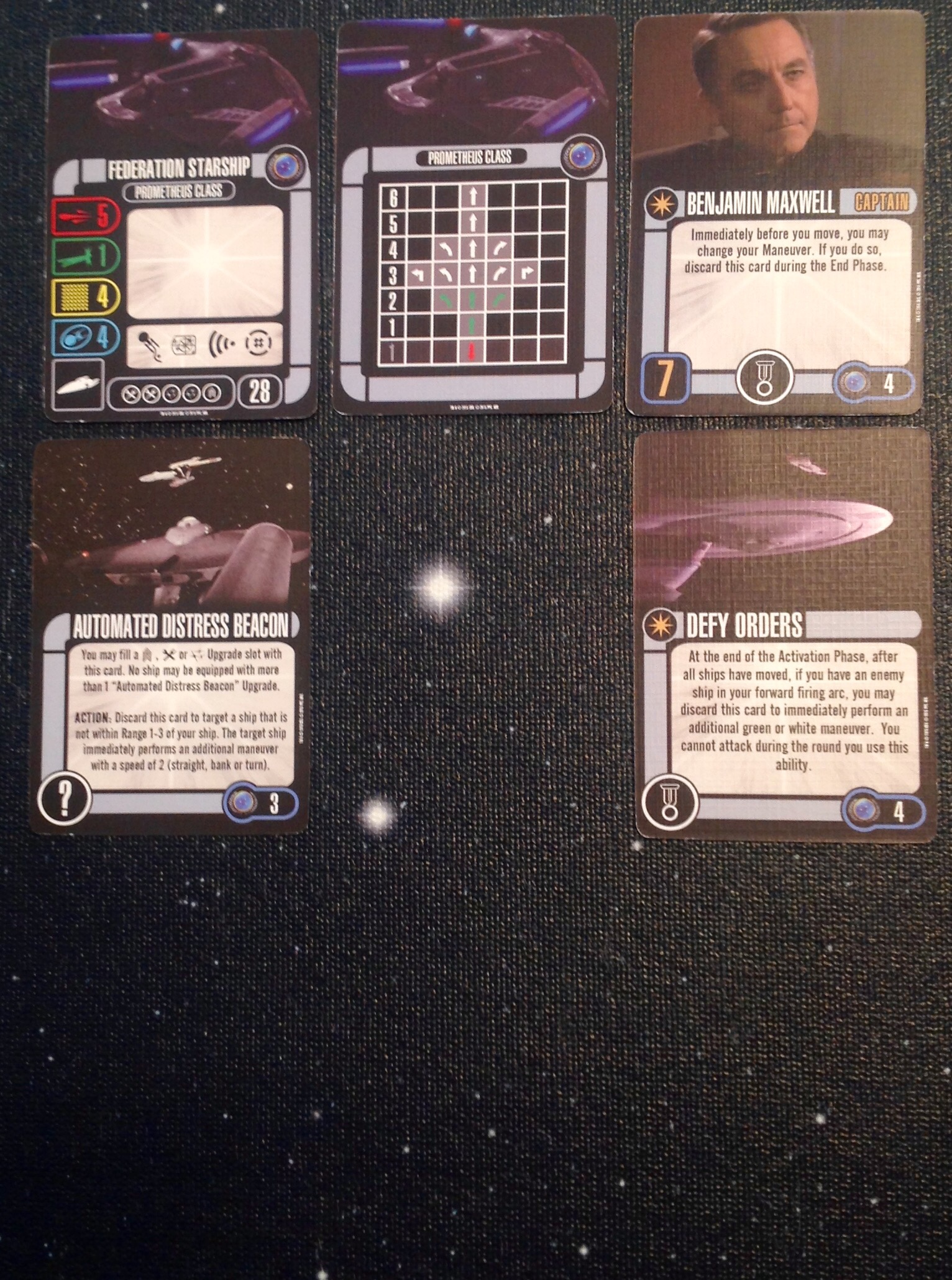
U.S.S. Hathaway [U.S.S. Hathaway] (22)
Benjamin Sisko [Deep Space 9] (4)
Flag Officer [U.S.S. Intrepid] (4)
Montgomery Scott [H.M.S. Bounty] (4)
Wesley Crusher [U.S.S. Montgolfier] (5)
Thruster Array [U.S.S. Montgolfier] (3)
Automated Distress Beacon [U.S.S. Constellation] (3)
Total (45)
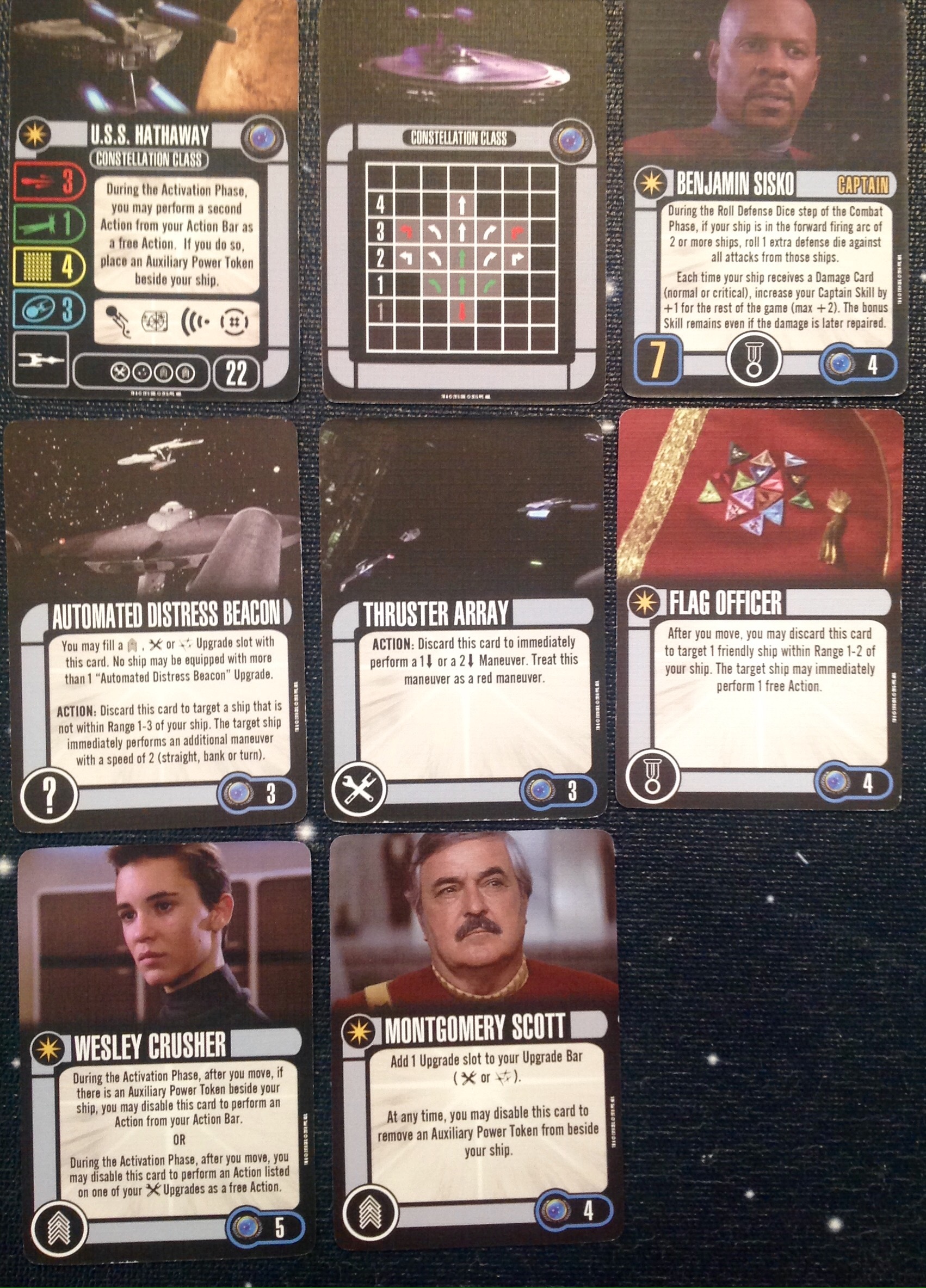
Emergency Power (5)
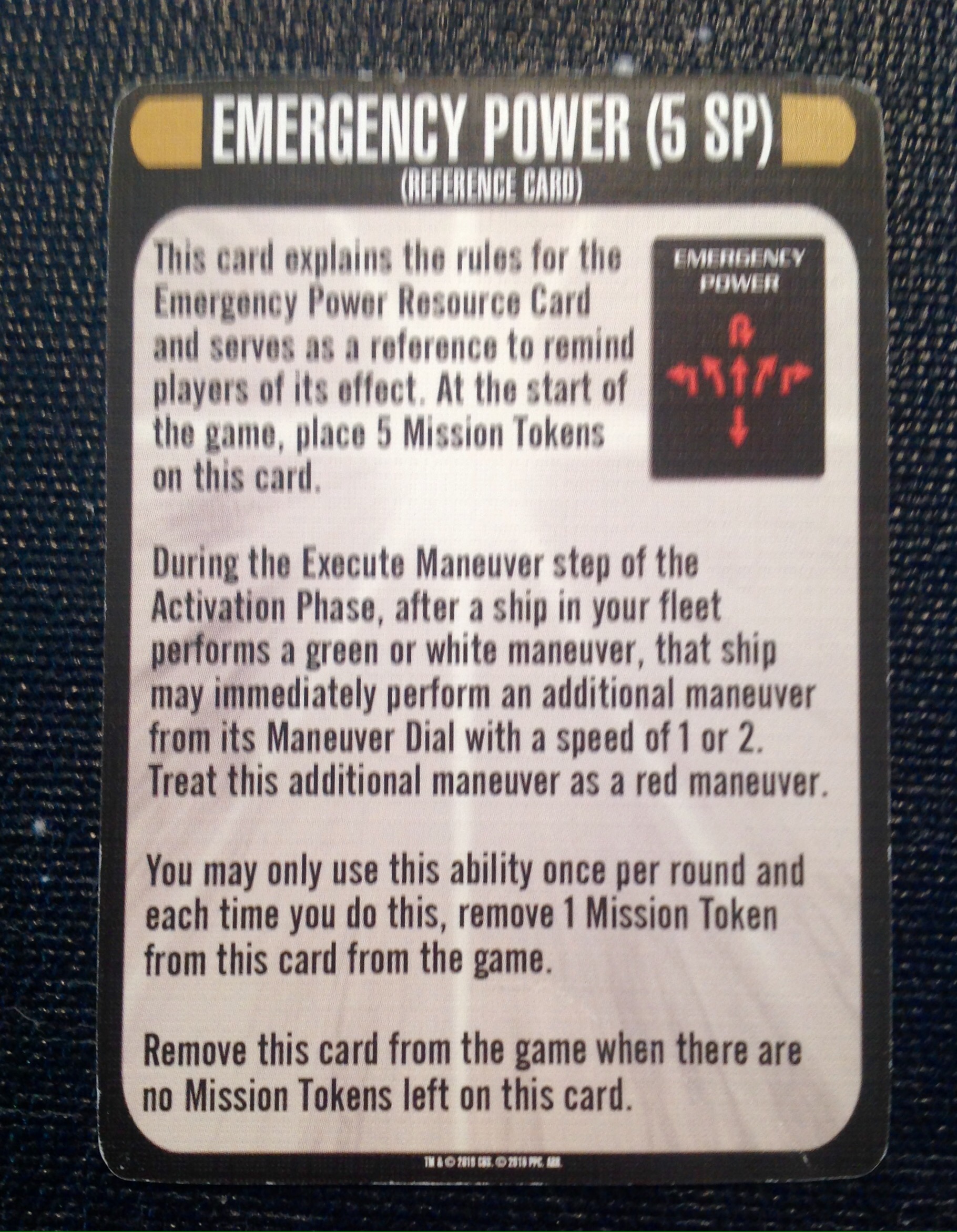
Fleet total: 130
Generated by Space Dock for iOS
http://spacedockapp.org
Flying The Rabbit Build
Yes, it’s the USS Raven, but we named it the Rabbit. The goal was to get the Rabbit as far ahead as possible, as quickly as possible. The Prometheus-class (let’s just call it the Prometheus, even though it’s not the named ship) is a fast ship in its own right, but mostly it’s for blocking. The Hathaway is almost a throwaway. but, it still has an important role to play. The resource, Emergency Power doesn’t figure into the opening move, but is useful in the middle or late game if needed.
First a word on the captains. Other than Picard’s ability, the other captains’ abilities are not important. The important thing is that all three captain have the same skill level. Picard’s 6 gets a boost of 1 from Admiral Forrest. It’s possible to use the other two captains to attempt to distract your opponent before you start playing.
The same thing for the Ships’ abilities. They are really immaterial. The important characteristics are the upgrade slots and most importantly the maneuvers that each ship is capable of.
Assuming you are playing from the Southern Edge, The Rabbit sets up exactly 13″ from the Western edge and against the very Southern edge. The Prometheus sets up 11″ from the East edge and 4″ from the Southern Edge. The Hathaway sits just West of the Prometheus.

By having all captains at a Skill 7, the Federation player gets to move all his ships together and in any order. The Prometheus moves first by going STRAIGHT 6. This puts it more than Range 3 away from the Rabbit.

For his Action, he uses Automated Distress Beacon to move the Rabbit STRAIGHT 2.

Next up is the Hathaway. The Hathaway moves STRAIGHT 1. This puts it within Range 2 of the Rabbit.

Hathaway now discards Flag Officer allowing it to use an Action on a ship within Range 2. It targets Captain Picard’s captain Action.
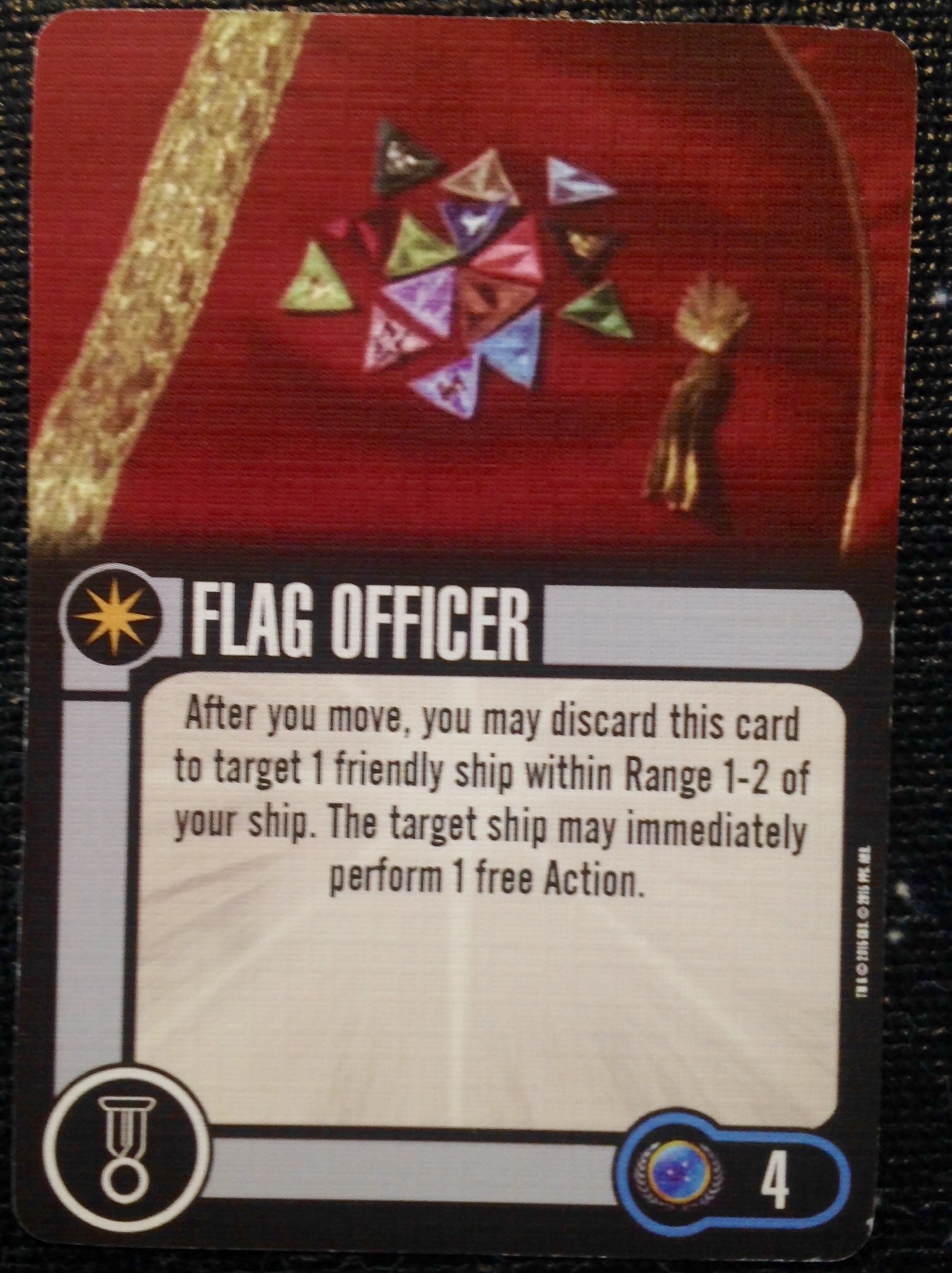
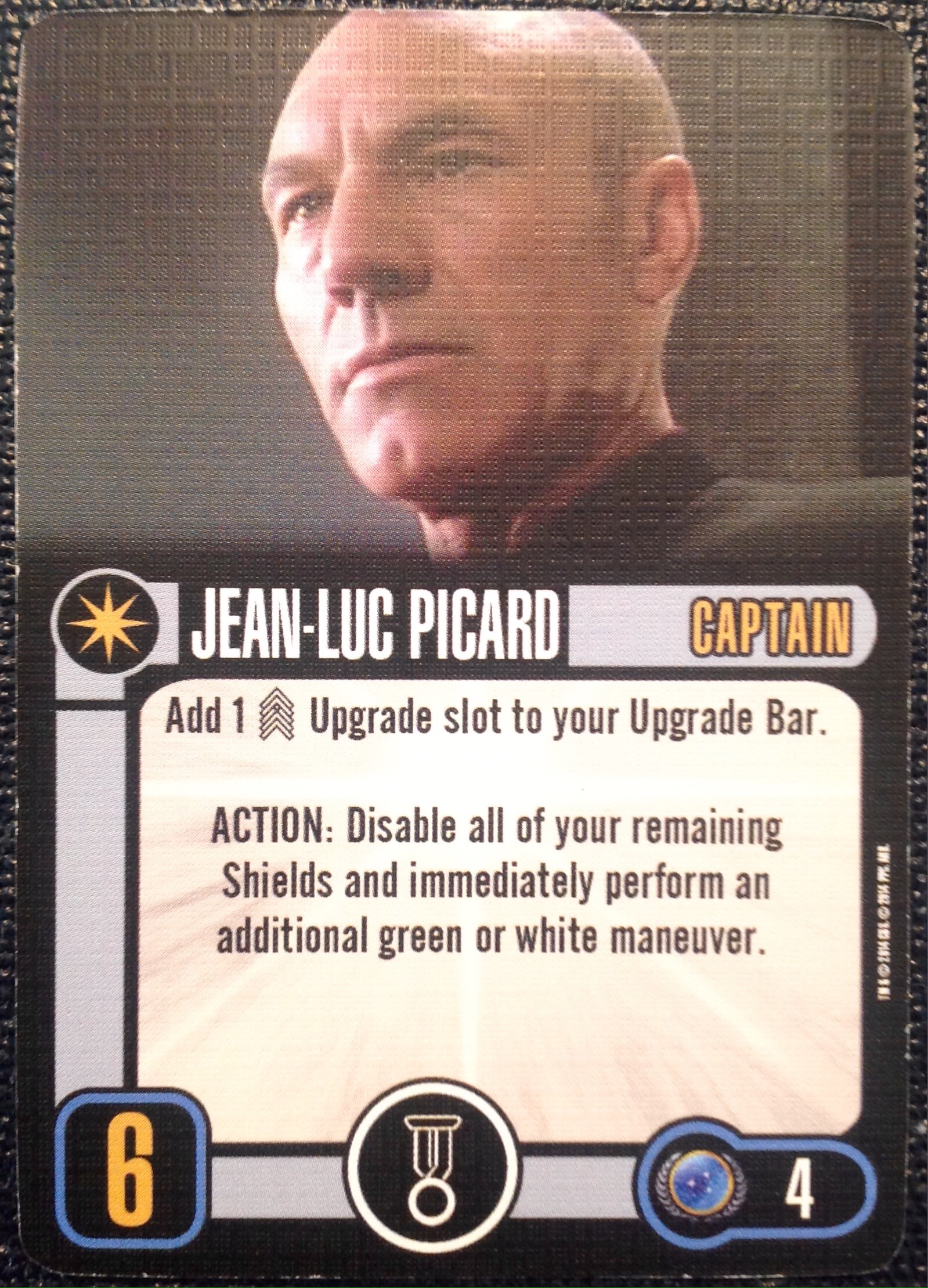
This allows the Rabbit to move STRAIGHT 4. At this point Hathaway disables Wesley Crusher to immediately use one of its Tech Upgrades. In this case it discards Thruster Array to move the Hathaway REVERSE 2 and take an Auxiliary Power Token (APT.)
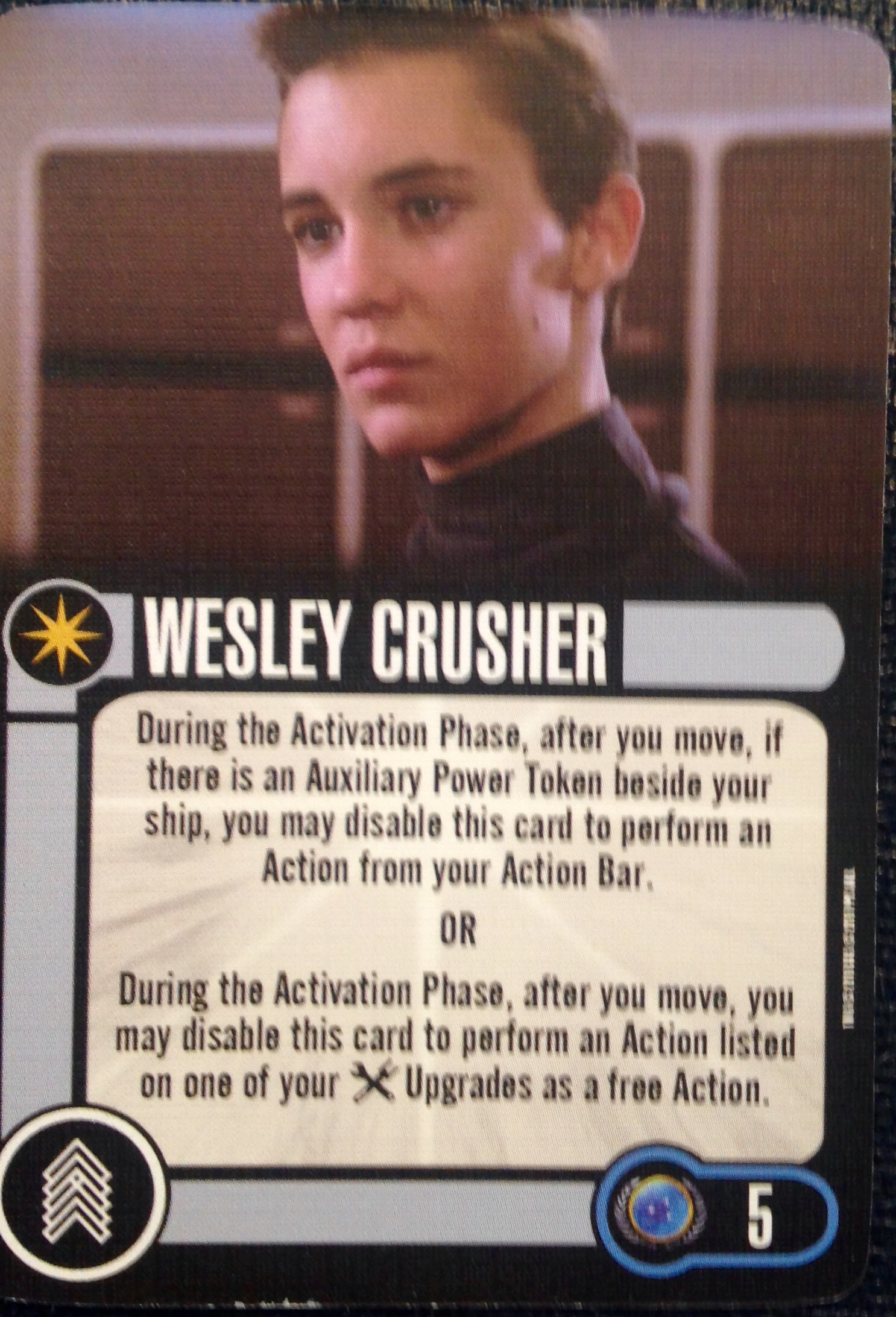
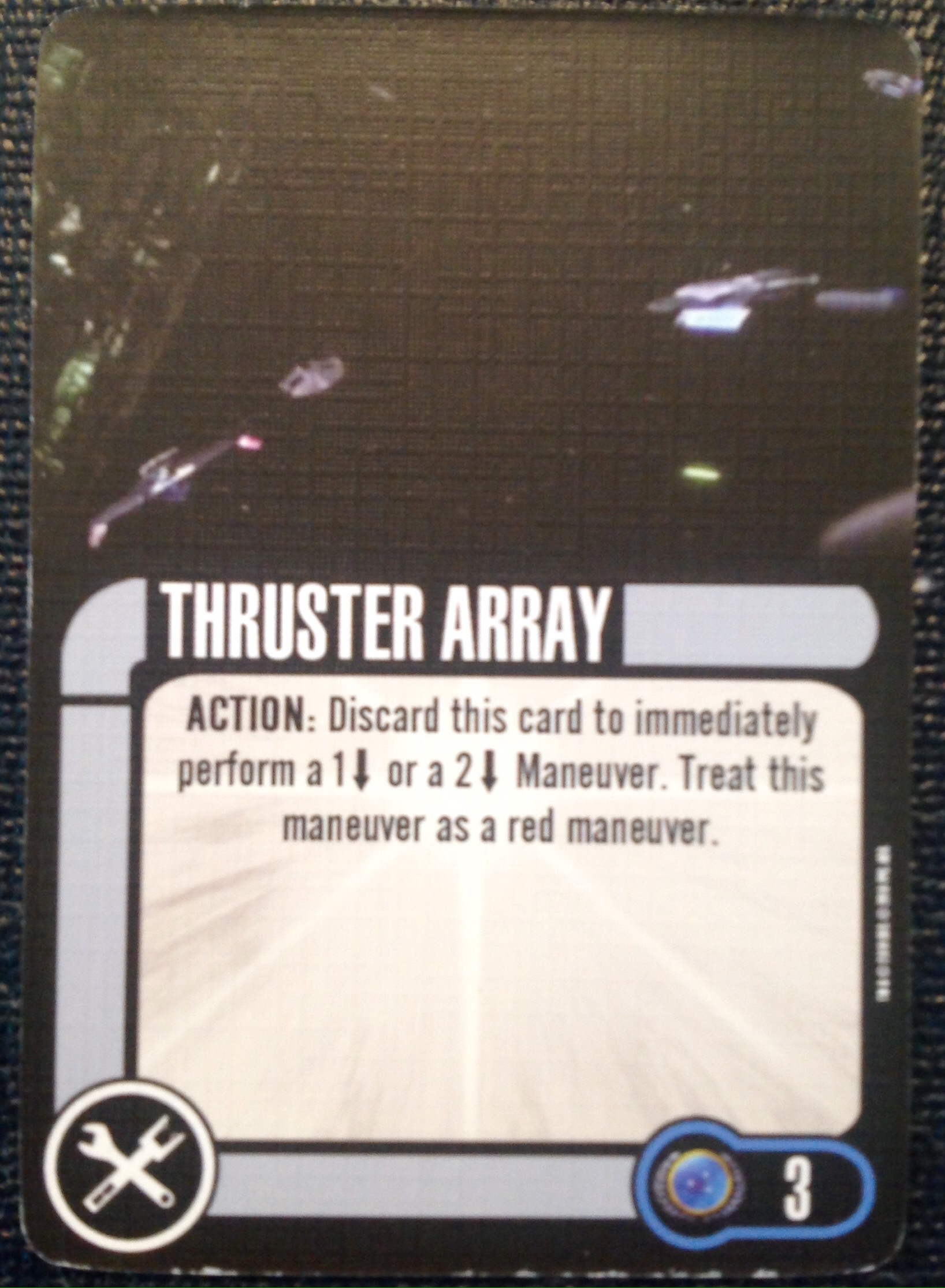
This puts the Hathaway more than Range 3 away from the Rabbit.

The Hathaway isn’t done. Next, it Disables Montgomery Scott to remove the Aux Token.
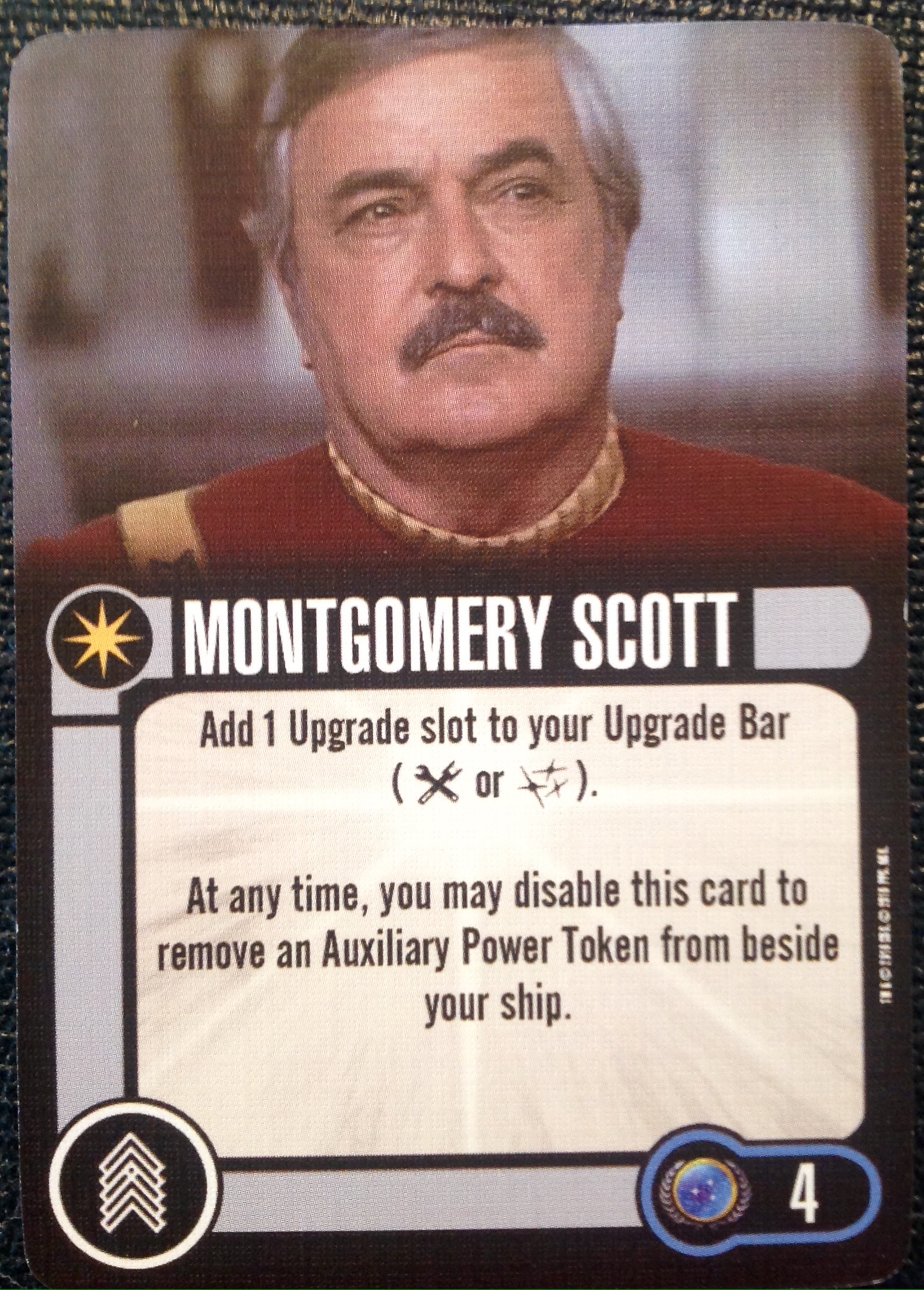
With the Aux Token gone and being more than Range 3 from the Rabbit, the Hathaway can activate it’s Action. It uses Automated Distress Beacon to move the Rabbit in a TURN 2 to the right.
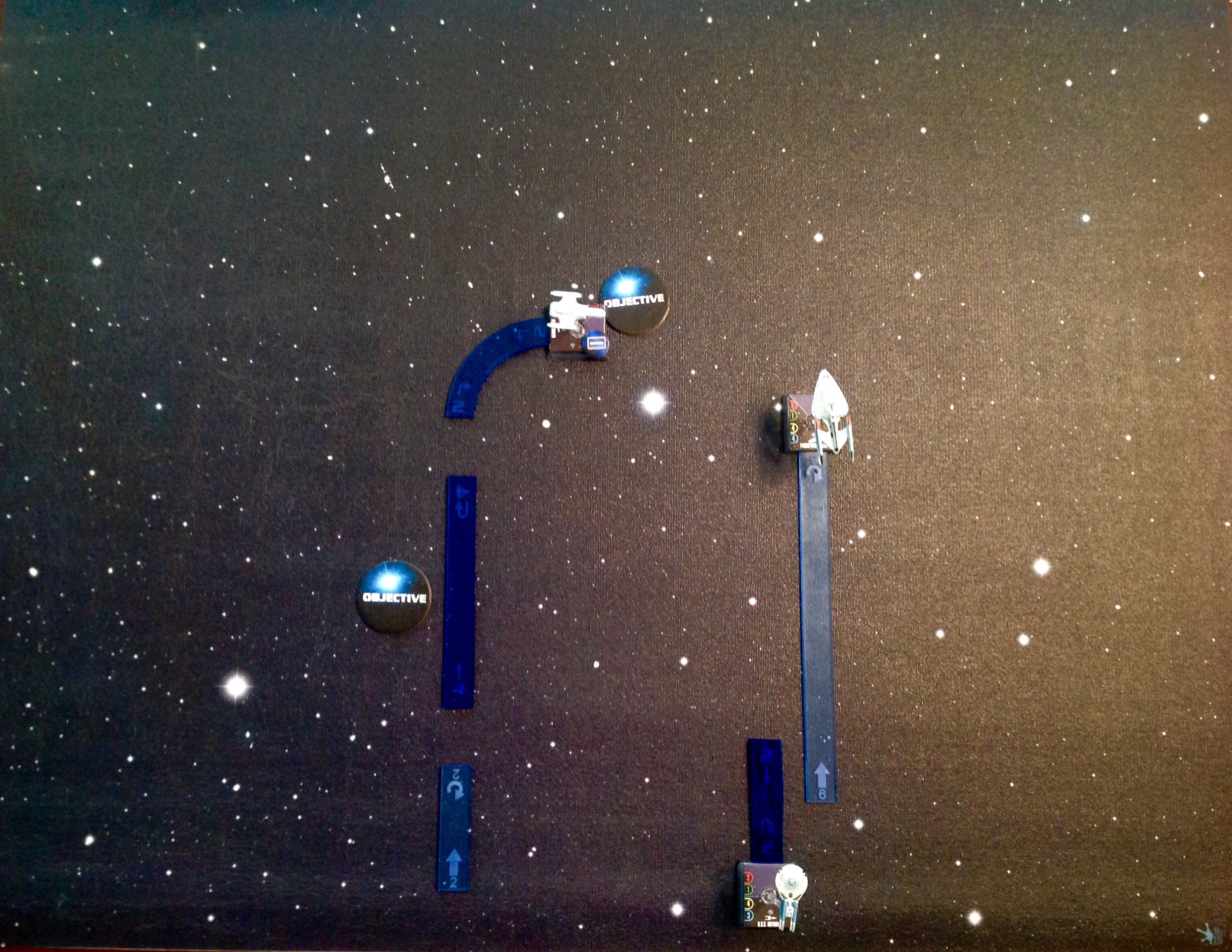
It is now the Rabbit’s turn to move and it’s already through the first portal. In Chronological Chaos, the first portal is in a set location. The second portal could be anywhere on the board. I have placed the second portal in what I consider the worst possible location for the Rabbit. As you’ll see, the Rabbit is going to have to reverse course to get back to the second portal.
The Rabbit first does a COME ABOUT 2.
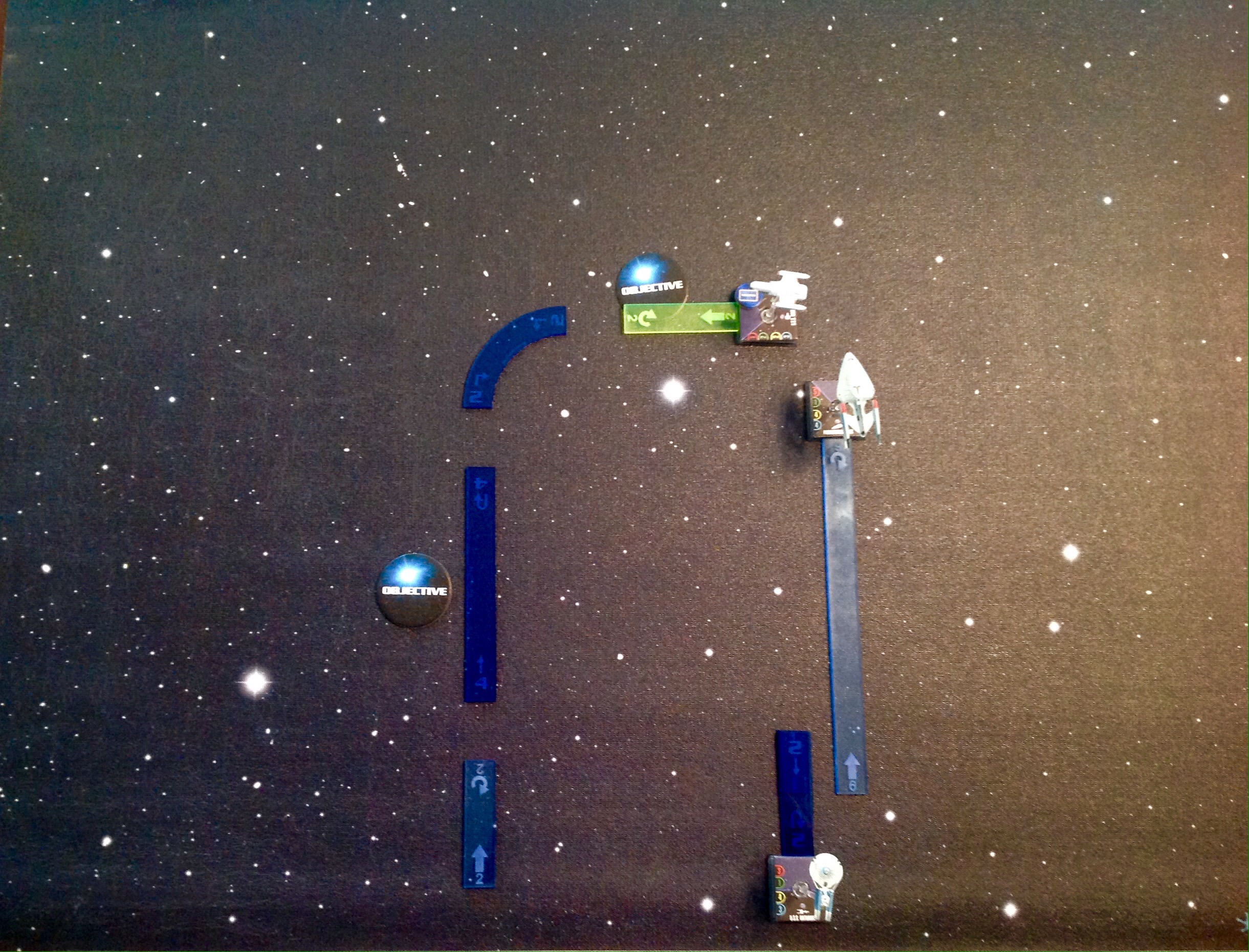
For its Action, the Rabbit uses Admiral Forrest’s Fleet Action to BANK 1 to the left.
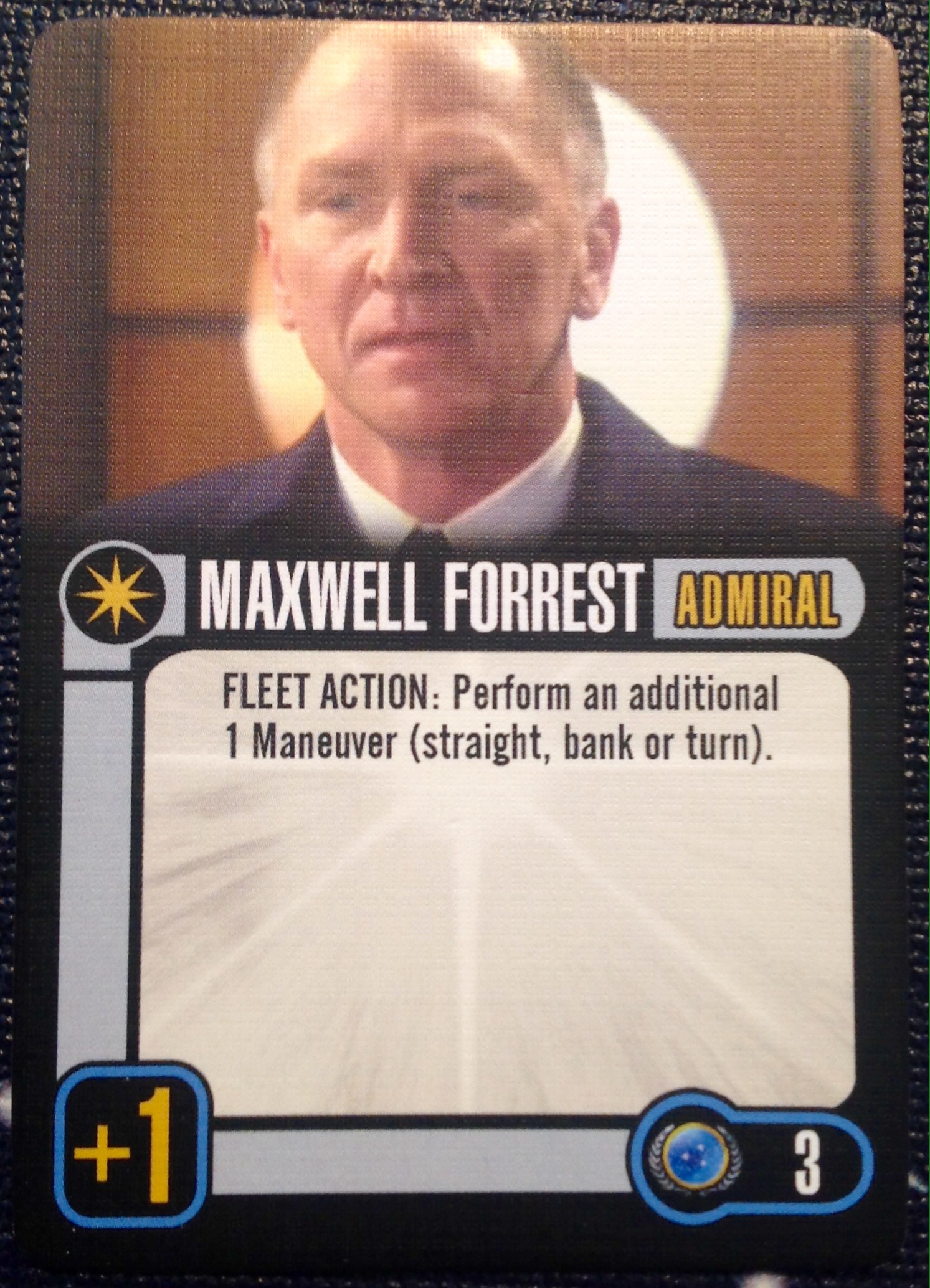
This aligns the Rabbit toward the second portal.
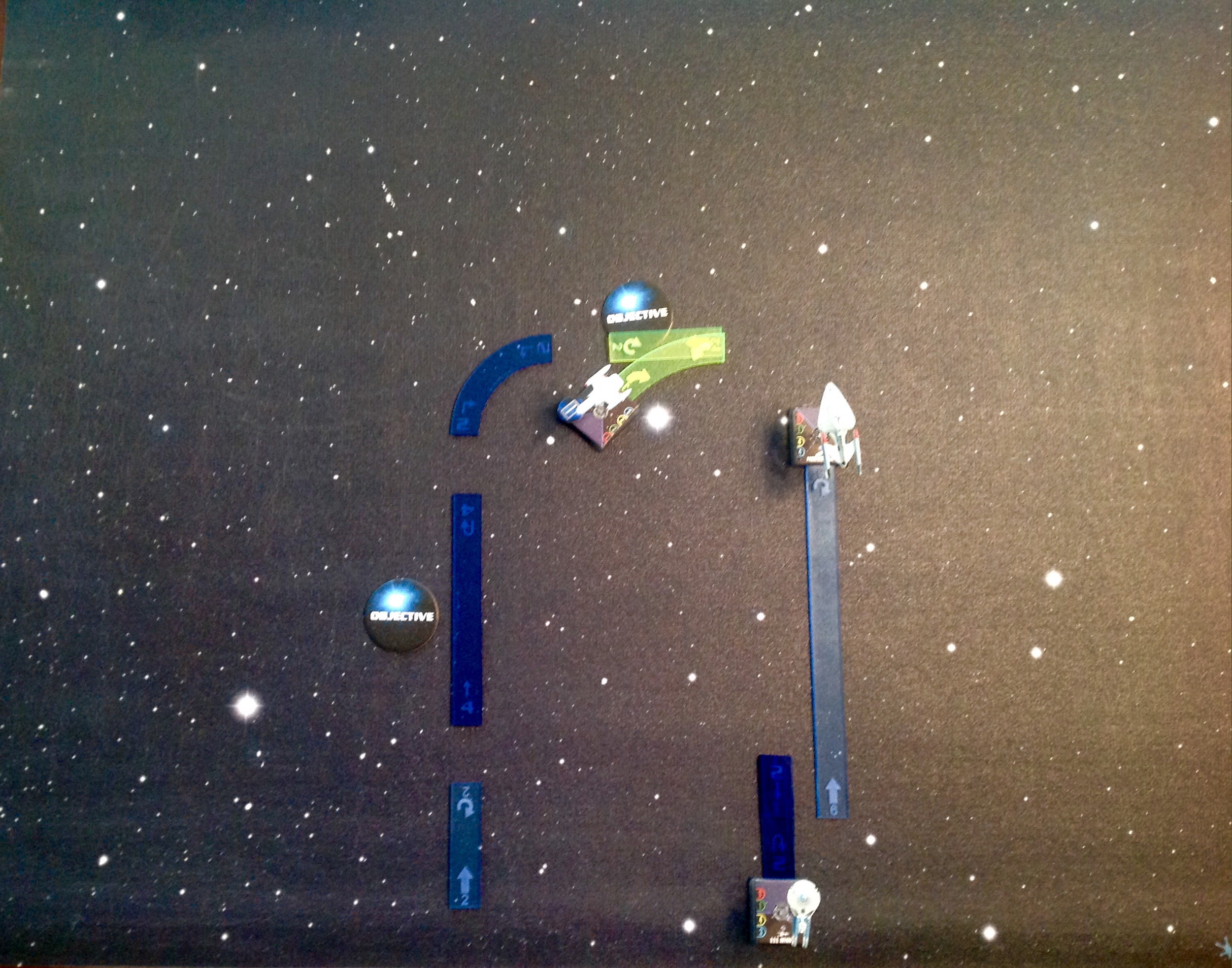
Next, the Rabbit disables William Riker to allow it to perform a free Action. Rabbit performs the Picard Maneuver to move STRAIGHT 5.
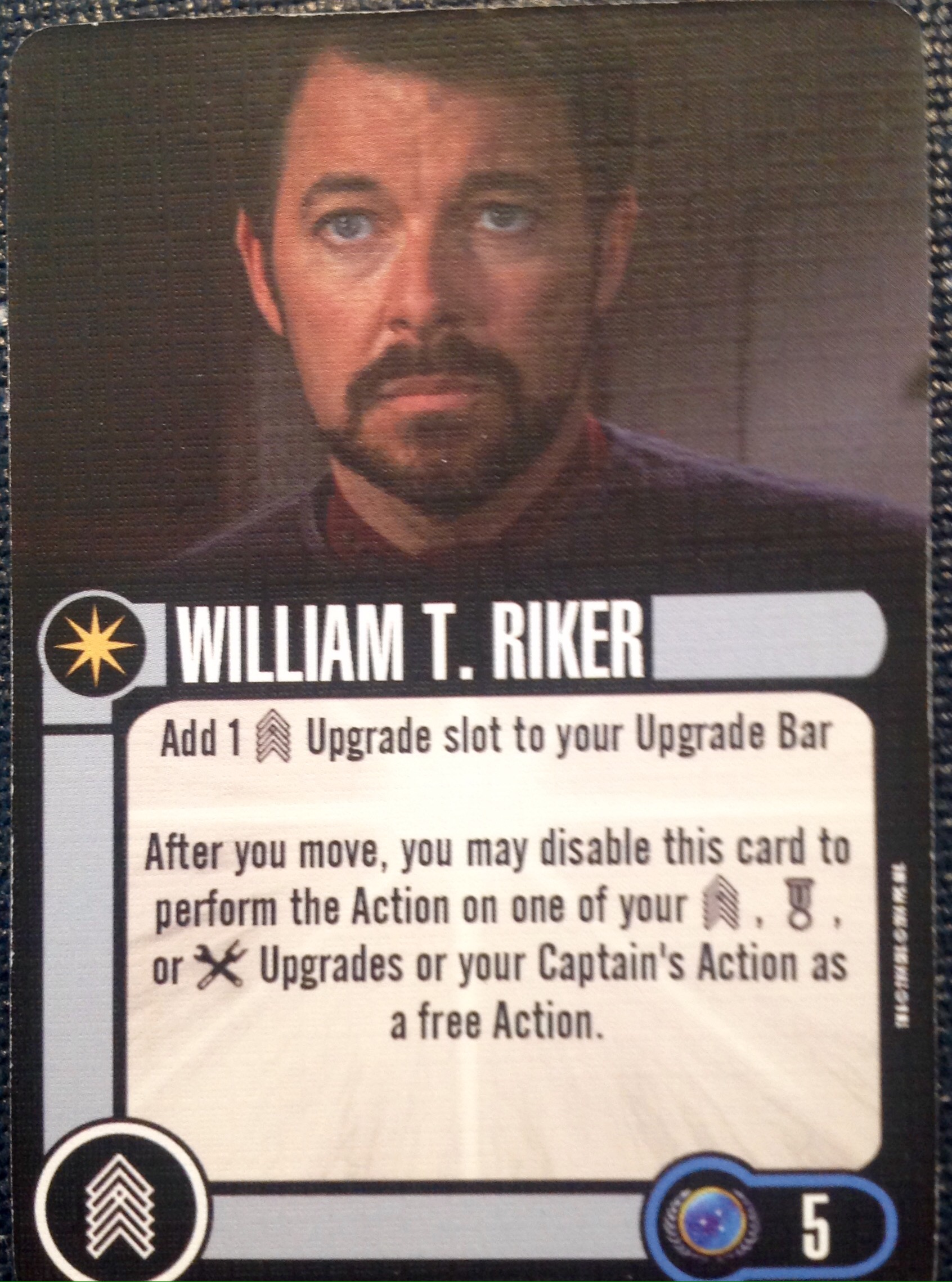
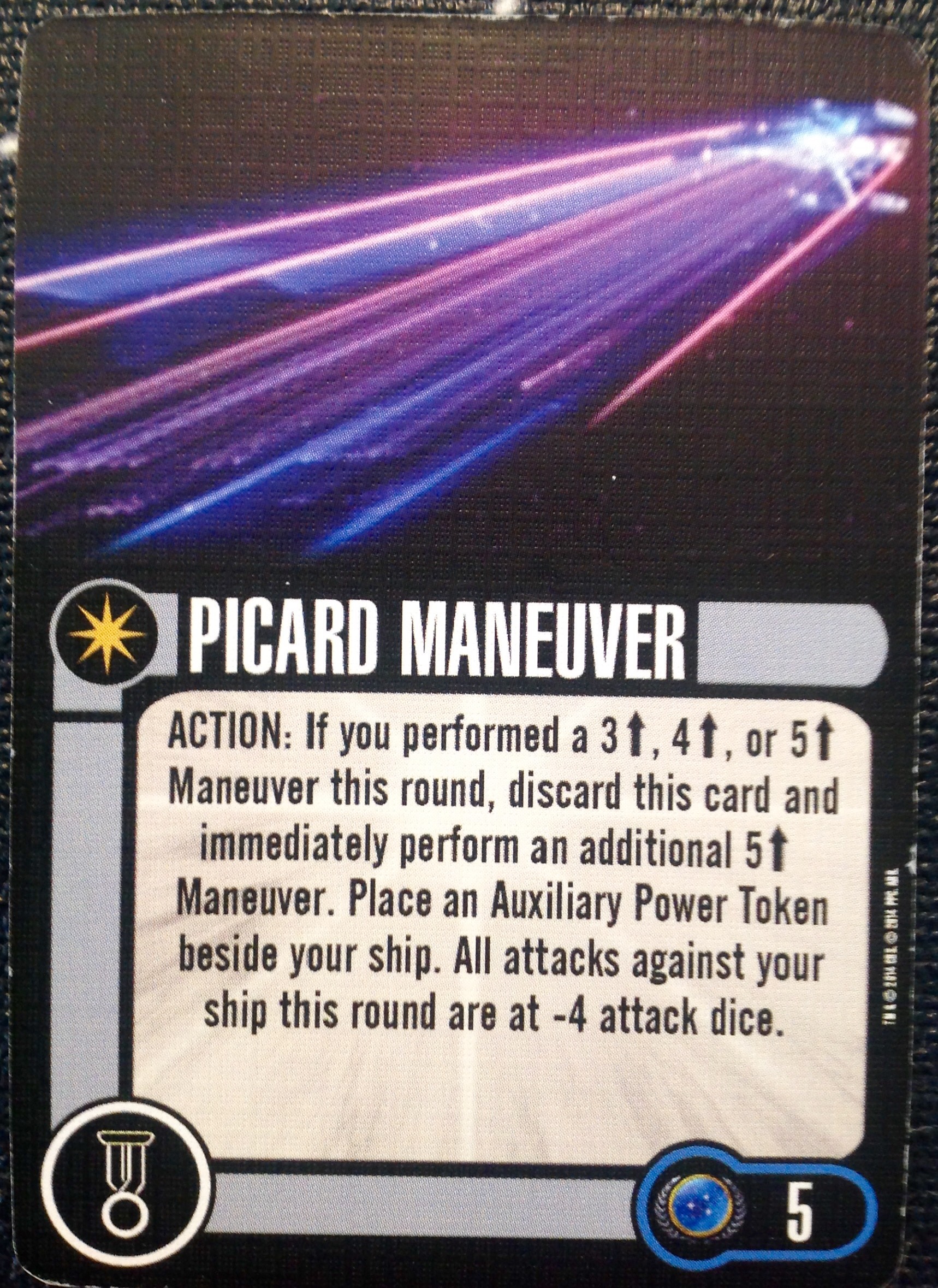
The Rabbit is done moving and is now through portal 2.
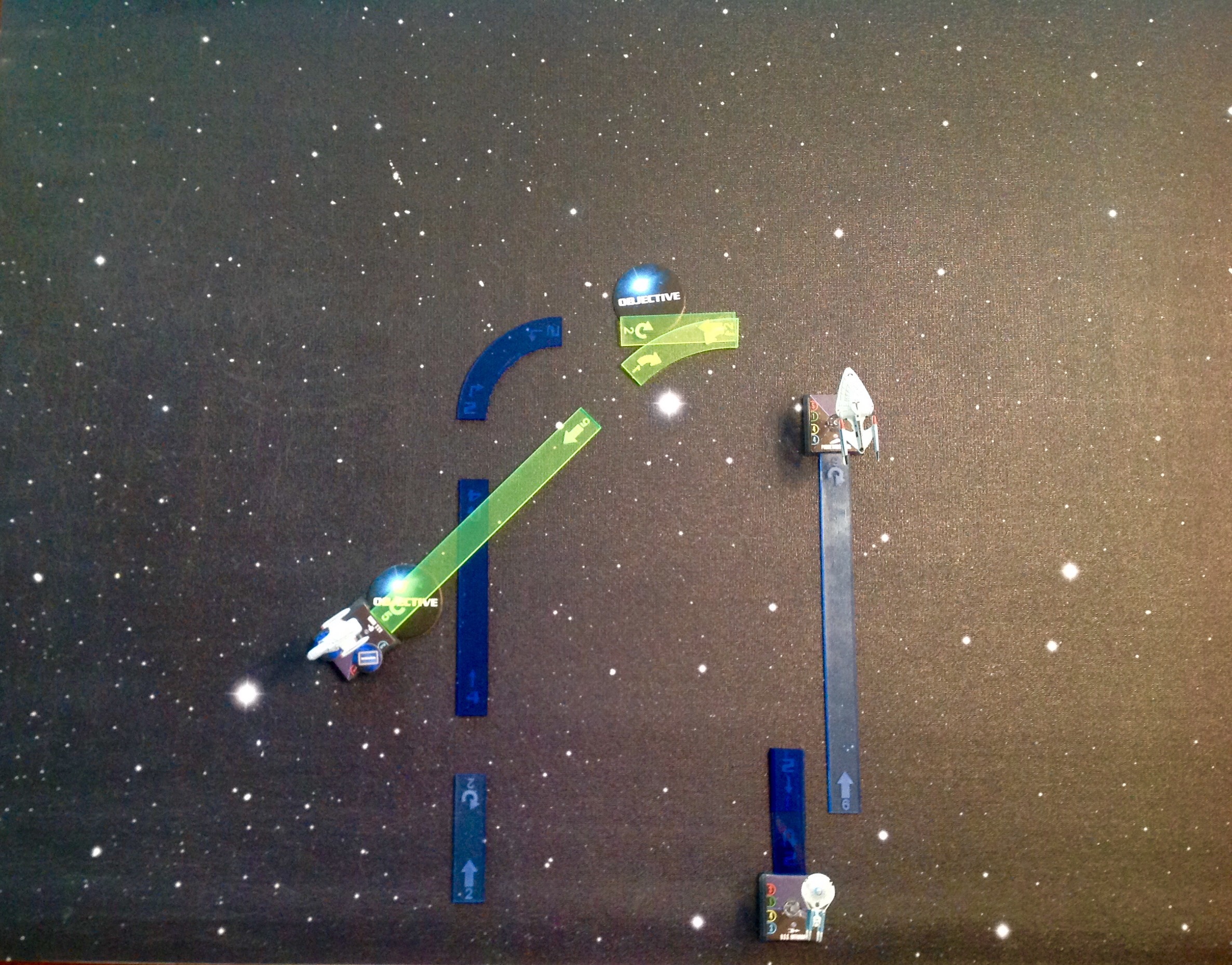
But, the play is not yet over. At the end of the Activation Phase the opposing player will undoubtably be close to Portal 1. And Prometheus will likely be within the forward firing arc of an enemy ship. Prometheus now discards the Obey Orders upgrade to allow it to TURN 3 to the left to move through the first portal.
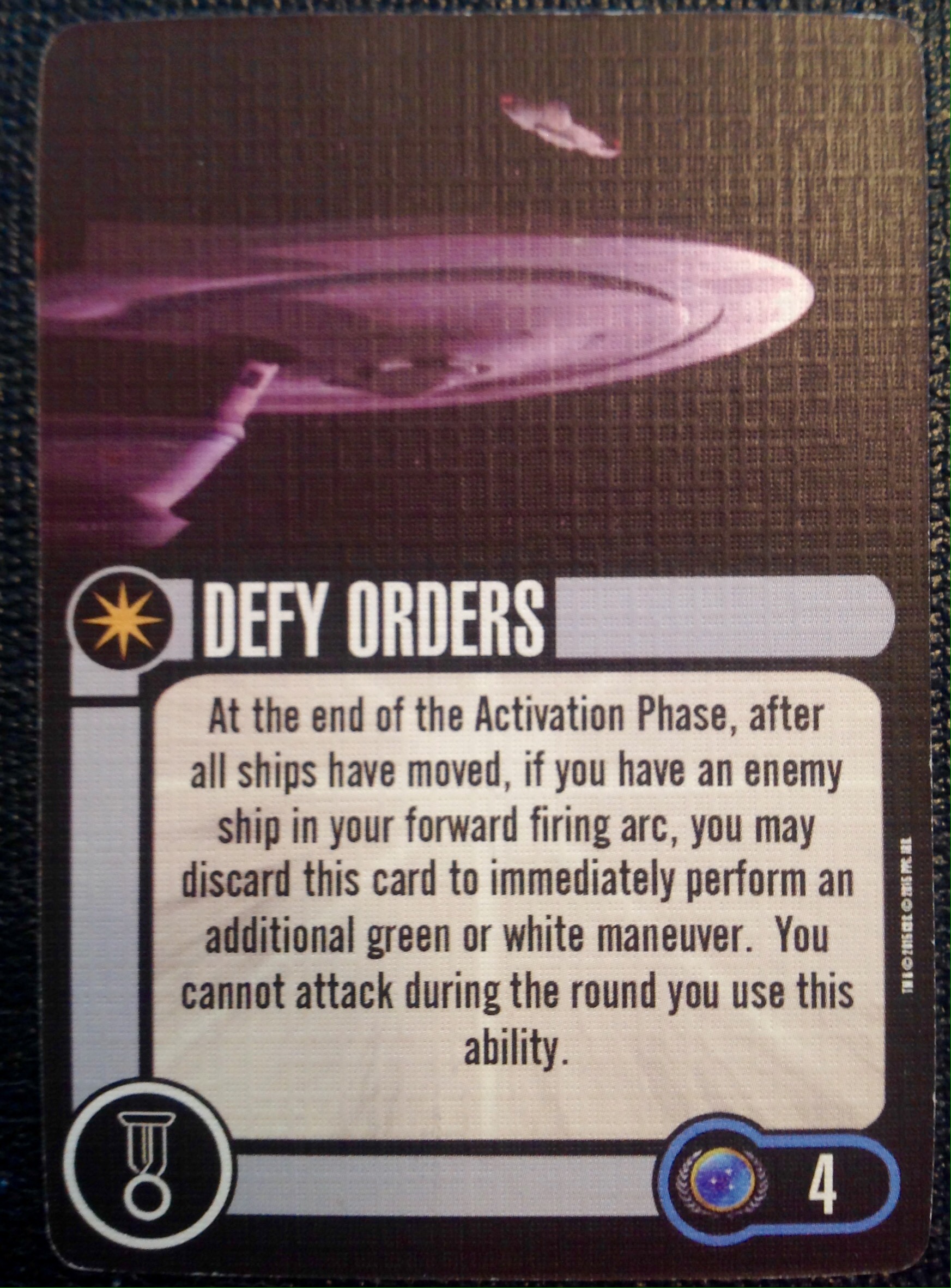
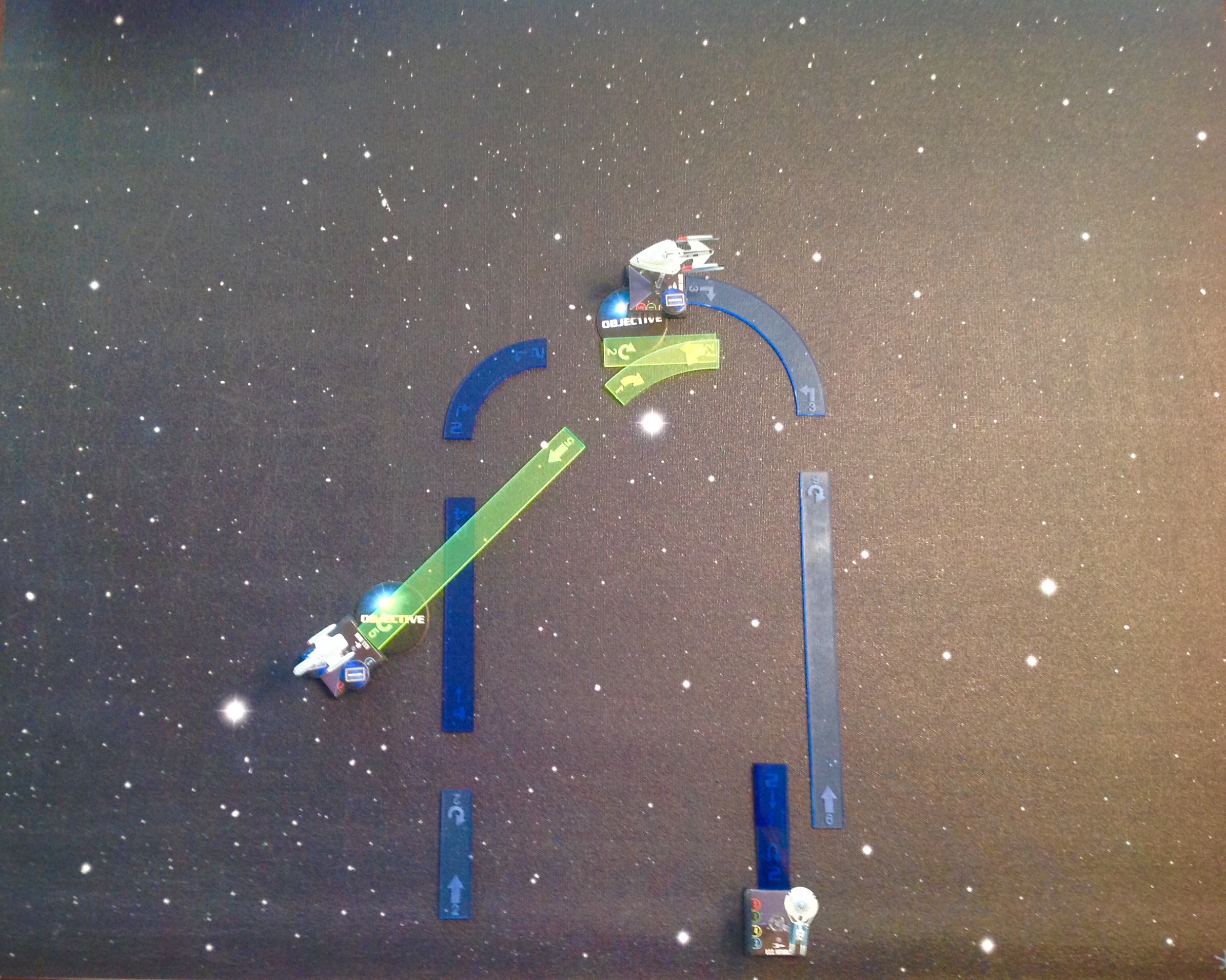
The Race To The Finish
So, at the end of the first Activation Phase, the Rabbit Build has one ship in the original location. One ship has gone through one portal and the second ship, the Rabbit, is through two portals. The Rabbit has moved the equivalent of 20, about 30″. As the Rabbit makes its run to the finish, the ship will be able to move STRAIGHT 4 and the Transwarp Drive will bump that by STRAIGHT 2, for a base speed of STRAIGHT 6 each turn.
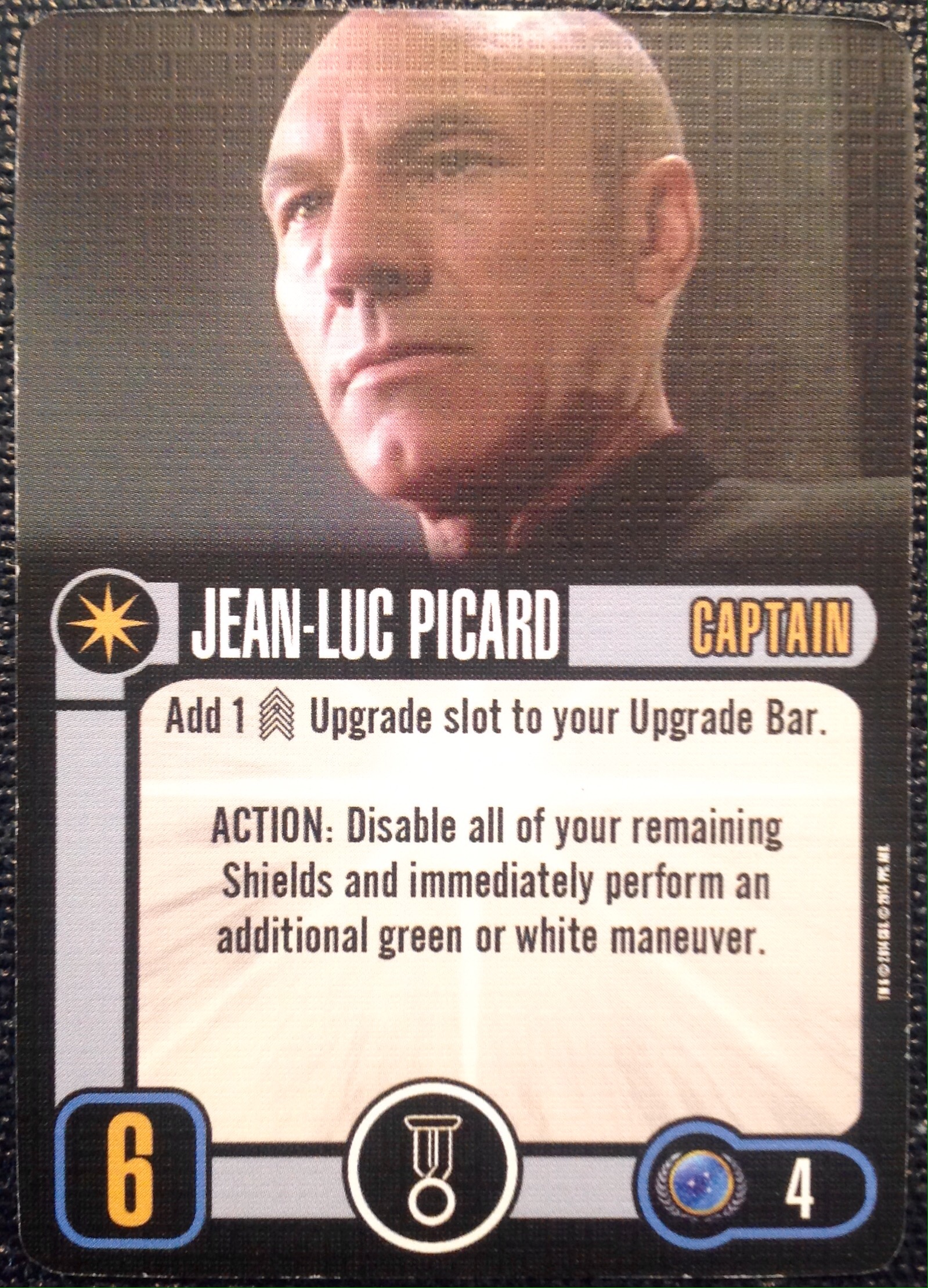
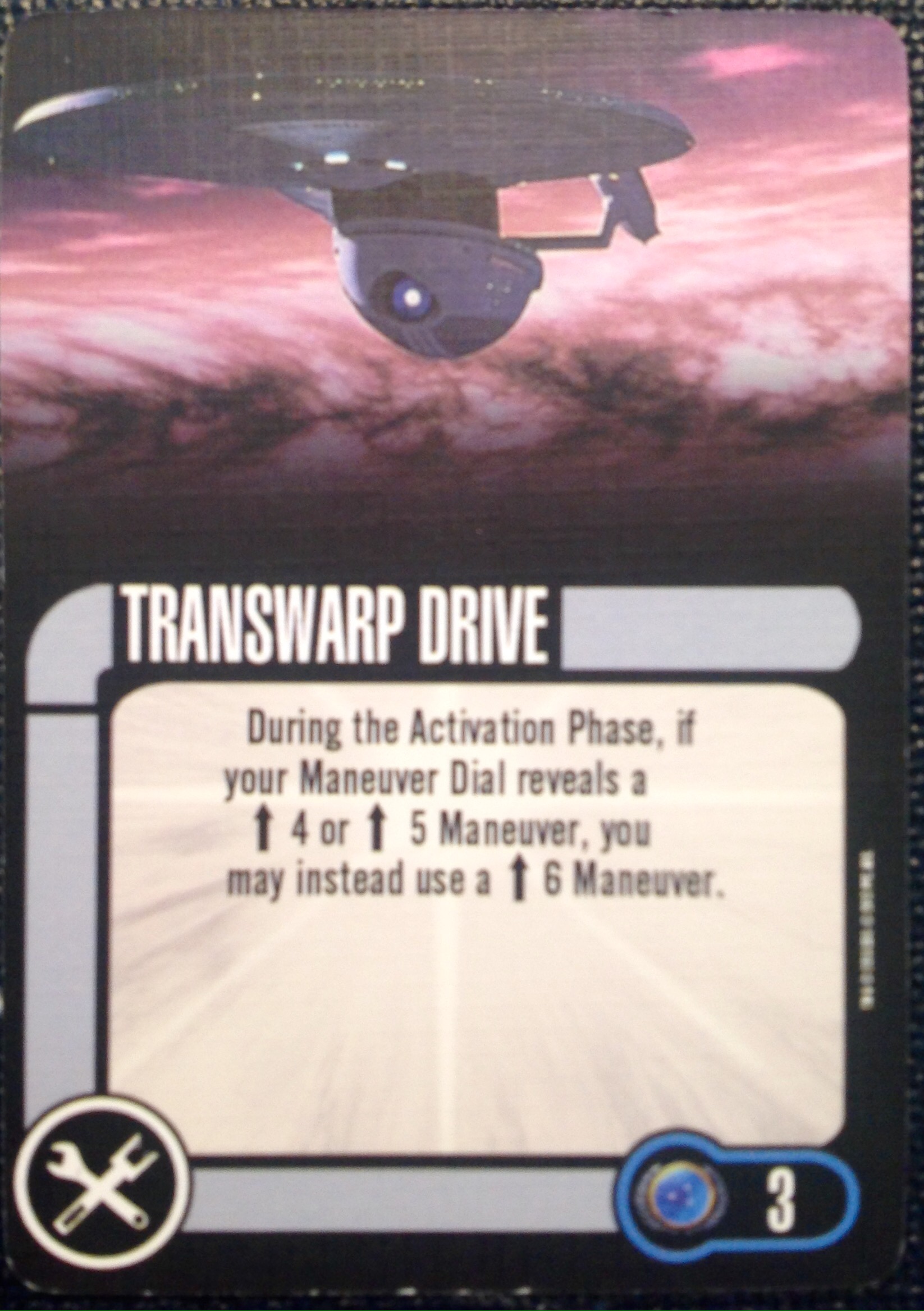
In addition, Captain Picard’s captain Ability will allow an additional STRAIGHT 4. In addition, the Rabbit will be able to use Admiral Forrest’s free movement, as well as the Emergency power.
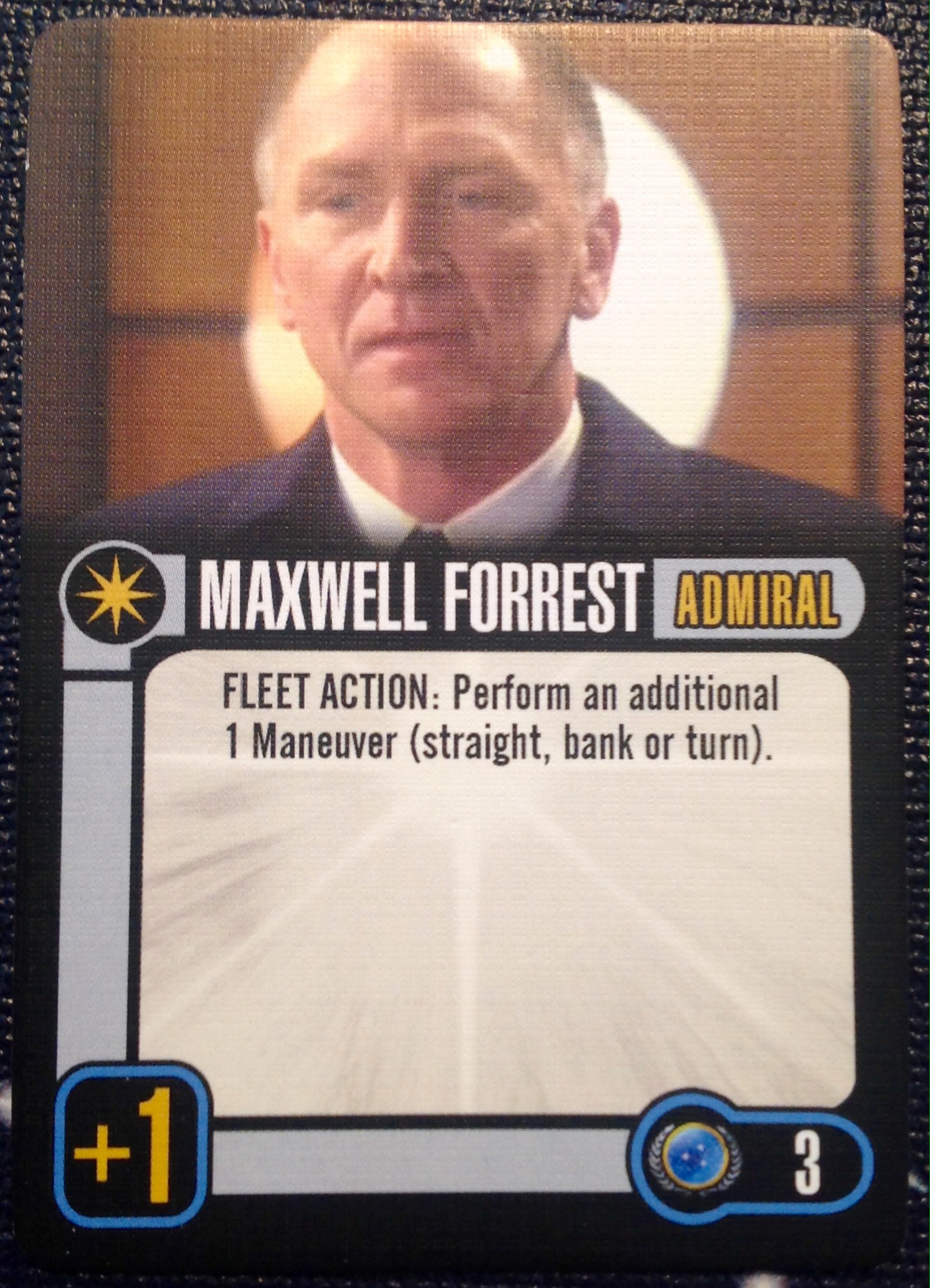
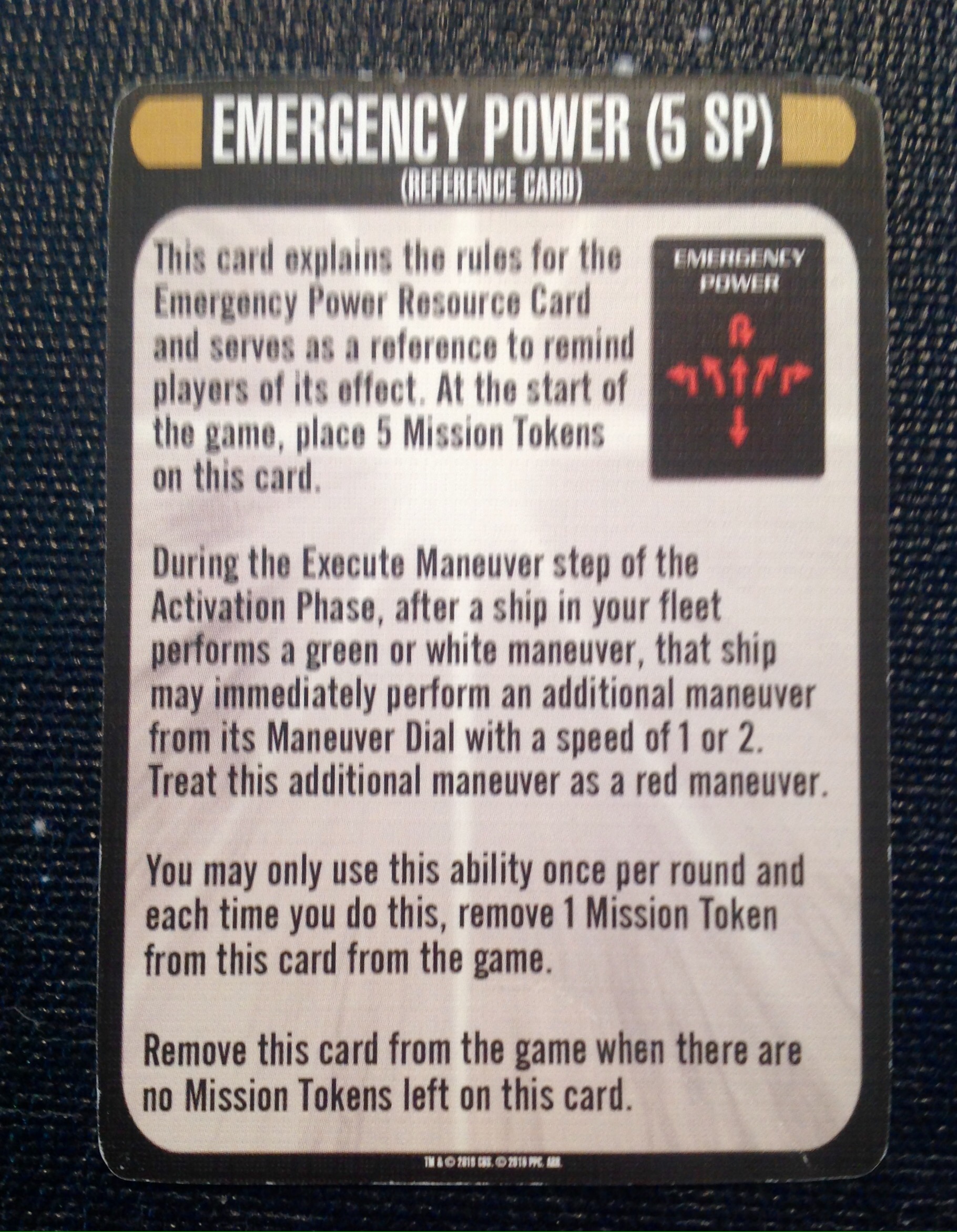
At the beginning I described this as an unbeatable build. Is it beatable? I don’t think so. I played against it and tried using Jennifer Sisko which allowed me to disable two upgrades on the Rabbit. It slowed him only a little. And I had to build a fleet designed to stop him, not necessarily to win.
It’s always possible that a player might still fly badly. In fact, during the Chronological Chaos OP, my son was so anxious that he ended up flying the Rabbit off the board on his first turn. He still won by racing the Prometheus to the end.
But, barring any mistakes in the execution, I don’t think it’s possible to build a fleet that is faster than the Rabbit, and the fact that the Rabbit ends up through two portals before the end of the first Activation Phase means that no one is going to be able to shoot at it. The Prometheus can act as a blocker, disrupting or firing on any ship chasing the Rabbit. The Hathaway, having fulfilled it’s role in the first Activation Phase simply needs to stay out of the way, but even if it gets killed, when the Rabbit hits the fourth portal, the Federation player wins regardless.
This is the second in a series of posts about Star Trek Attack Wing:
Tuesday: An introduction to Star Trek Attack Wing
Wednesday: Chronological Chaos OP: An Unbeatable Build?
Thursday: Throwback Thursday: Winning the Klingon Civil War OPs with more unbeatable builds
Friday: STAW is DEFINITELY Pay-to-play. . .And players should be grateful it is
Enoch Bliss gets the lion’s share of the credit for designing The Rabbit Build.
Rodney M Bliss is an author, columnist and IT Consultant. His blog updates every weekday. He lives in Pleasant Grove, UT with his lovely wife, thirteen children and grandchildren.
Follow him on
Twitter (@rodneymbliss)
Facebook (www.facebook.com/rbliss)
LinkedIn (www.LinkedIn.com/in/rbliss)
or email him at rbliss at msn dot com(c) 2017 Rodney M Bliss, all rights reserved
It’s all my brother’s fault. My brother is a world-class game player. His area of expertise is table top and strategy games. We’ve both played games since we were kids. At just two years apart, we were close enough in age to be interested in many of the same things. And yet we were far enough apart that he was typically the one learning a new game and then teaching it to me.
We played the standard Monopoly, Risk, Stratego, but quickly moved into more involved games like Axis and Allies, Diplomacy (yes, you can play it 2-player, but it’s not the same,) Squad Leader, Lord of the Rings and dozens that I’ve forgotten over the years. We also played role playing games. We had first edition copies of Dungeons & Dragons, Melee, Car Wars and many more.
As we grew up and had our own families, game playing became more infrequent. Well, at least for me. My kids like playing games, but what they really enjoy is Uncle Rick coming over at Thanksgiving and bringing new games. My brother’s family and mine don’t exchange Christmas gifts. But, every Thanksgiving he sends us a new game. Last year it was this table top game called Star Trek Attack Wing (STAW.)
The premise is simply. You are captain of a ship in the Star Trek universe and you are doing battle with another ship in the Star Trek universe. One of the enjoyable aspects of the game is that you use actual models. They are about an inch by an inch and a half. The play area is any 3′ x 3′ open area like a table top.
The $40 starter set that he sent us includes three ships, the U.S.S. Enterprise-D, a Klingon RMB and a Romulan RMB ship. Each ship has certain characteristics: Main or Primary Weapon strength, an evasion rating, a Shield strength and a number of hits for the Hull, and then a set of allowable maneuvers
The game is pretty simple. Use the manuevers to fly your ship close to the enemy ship, use you weapons to attack him. Each hit takes off one Shield. When your Shields are gone, then each hit counts against your Hull. Once he has taken more hits than he has on his Hull, his ship is dead and you win.
WAIT A MINUTE! Star Trek was not about fighting. It’s motto is “seek out new life and new civilizations.” The STAW game better fits the Schlock Mercenary motto of “Explore the galaxy, meet exciting new life forms and then kill them.” This is just the first mental compromise you have to make when playing STAW. There are scenarios that you can play through, but honestly, the game is really about killing the other guy before he kills you.
The militaristic mission statement isn’t the biggest departure from the TV show and movies. Because, the strength of the game is all about outfitting your ships. In addition to the basic characteristics of PW, Evasion, Shields and Hull, each ship also has space for customization. The things you can add to your ships fall into the following catagories:
- Captains and Admirals: Several men captained the Enterprise over the years, Christopher Pike, James Kirk and Jean-Luc Picard. There are dozens of captains from the Federation and other races
- Elite Talents: These are special abilities. You know how Kirk always seemed to be able to cheat death? Yeah, there’s a card for that
- Crew: Riker, Chekov, that anonymous Red Shirt security officer
- Tech Upgrades: These are things that help your ship. Often they help you ship kill the other ship
- Weapons Upgrades: Who wants to always use their main phasers? Lots of extra weapons
What separates good players from poor ones, is how they choose to configure the crew and upgrades on their ship. What separates rich players from poor ones, is how much money they are willing to spend to get more ships, captains, crew, tech and weapons upgrades.
Where the game really departs from the theme of the show is that the game allows players to mix and match all of the above from different races, factions and eras. You can put a Klingon captain on your Federation ship, but you can also put your Federation captain on a Romulan ship, or put a Species 8472 crew on the ship of their sworn enemy the Borg. There are certain players who hate the idea of mixing factions. So much so, that game stores, (in the STAW community called Friendly Local Game Stores, or FLGS) often employ house rules limiting the possible combinations. The common restrictions fall into several broad categories:
- Penalty Pure: Only a single faction, but you can use other faction upgrades by paying a penalty
- Faction Pure: Only a single faction allowed for your entire fleet
- Fleet Pure: Similar to Faction Pure. Your entire fleet must be from a single faction
- Ship Pure: Like Faction Pure, but only for each ship. So, you could have both a Romulan ship with only Romulan upgrades and a Federation ship with only Federation upgrades in your fleet
- Era Pure: All Captains, Admirals, Crews and ships must be from the same era, Star Trek: Enterpirse (STE), Star Trek: The Original Series (TOS) or Star Trek: The Next Generation (ST:TNG)
STAW is marketed by WizKids. And what makes it different than Monopoly, or Risk, or even games like Squad Leader or Dungean & Dragons is that WizKids regularly releases new ships and holds bimonthly Organized Play (OP) events. An OP has a specific mission and includes prizes for the player who wins the OP tournament at their FLGS. Players can also compete in Regional and National tournaments held every year.
I mentioned at the beginning that my involvement in STAW is all my brother’s fault. He gave us that 3-ship starter set last year. Today, I own over 350 ships and the accompanying cards fill nearly a dozen notebooks.
This is the first in a series of posts about Star Trek Attack Wing:
Tuesday: An introduction to Star Trek Attack Wing
Wednesday: Chronological Chaos OP: An Unbeatable Build?
Thursday: Throwback Thursday: Winning the Klingon Civil War OPs with more unbeatable builds
Friday: STAW is DEFINITELY Pay-to-play. . .And players should be grateful it is
Rodney M Bliss is an author, columnist and IT Consultant. His blog updates every weekday. He lives in Pleasant Grove, UT with his lovely wife, thirteen children and grandchildren.
Follow him on
Twitter (@rodneymbliss)
Facebook (www.facebook.com/rbliss)
LinkedIn (www.LinkedIn.com/in/rbliss)
or email him at rbliss at msn dot com(c) 2017 Rodney M Bliss, all rights reserved
It’s my own fault. As I write this, it is 3:12AM. I’m up this early waiting for my shuttle ride to the airport. My flight to Shreveport, LA leaves Salt Lake Airport at 6:00AM. This early flight will put me into Shreveport just after noon.
The thing is, today is a travel day. I don’t need to be at meetings until tomorrow. So, why am I up in the middle of the night to catch an 0’dark-thirty flight?
Because I don’t want to be a jerk.
At least that’s the way I saw it last week when my flight information came through. Like many business travellers, I don’t book my own travel. We have, not so much a department, but a designated “travel booker.” I fill out a travel request form, get it approved by my manager and the travel booker takes it from there. The travel request form asks for “preferred departure time?” The default is ANYTIME. I took the default.
Why? Because it literally doesn’t matter what time I leave.
A few months ago I was taking a trip to Port St Lucie in Florida. My boss was flying in from the East coast and we decided to share a car. The nearest airport to Port St Lucie is West Palm beach, about an hour away. I knew what time my boss was arriving and told the travel booker I needed to arrive in Flordia prior to his flight. It ended up the only way to do that was to leave at 12:30AM out of Salt Lake. It’s a lot longer to travel from Utah to Florida than it is from Virginia to Florida.
Afterwards, my boss gave me some sage advice,
Rodney, next time just put in for a car rental.
I know the reason I’m on the 6:00 AM flight. It’s cheaper. And saving money for the company is everyone’s responsibility. But, there’s being smart about saving money and being dumb about it. The account I’m working on is a multi-million dollar account. Many, many multi-millions. The difference between a 6:00 AM flight and a 9:00 AM flight is probably a few hundred dollars.
But, I worry about being the complainer. I have at times changed my flights. Or, rather made travel change my flights. Once, I needed to be back on a Saturday by 3:00 PM. Originally, even after I specified an “Arrival Time” of 3:00 PM or earlier, I found myself scheduled to arrive in SLC at 5:00 PM. At first, I just accepted it. But, again a senior manager said, “Just tell them to change it.” It cost the company money for me to arrive Saturday afternoon instead of Saturday evening.
The reason I needed to be back? My granddaughter was going to be in the Mutton Busting competition at the Pleasant Grove Strawberry Days Rodeo. My initial thought was “Really, I’m going to spend corporate money to see a rodeo?” My friend reminded me that I was already giving up most of a Saturday to travel after a full week of work away from my family.
Today’s trip may have finally tipped me over the edge. I lay in bed, several hours early last night trying unsuccessfully to convince my body to go to sleep. (I’ll sleep on the plane.) I tip-toed around this morning trying to make sure not to wake any of the babies, kids or adults in my house. And for what? So, I could have the cheapest flight.
It’s not really being a jerk, I realize. But, it’s still hard for me to spend company money. Still, the memory of my granddaughter in a vest and a helmet riding a sheep is one that I’ll treasure.
She lasted about 3 seconds. But, it was totally worth it.
Rodney M Bliss is an author, columnist and IT Consultant. His blog updates every weekday. He lives in Pleasant Grove, UT with his lovely wife, thirteen children and grandchildren.
Follow him on
Twitter (@rodneymbliss)
Facebook (www.facebook.com/rbliss)
LinkedIn (www.LinkedIn.com/in/rbliss)
or email him at rbliss at msn dot com(c) 2017 Rodney M Bliss, all rights reserved
When you are told to lead, follow or get out of the way, all three options are valid.
Lead: No one really worries about this. There are plenty of books on leadership.
Follow: Yes, this can really be a valid option. We are doing a big project that involves moving physical phones on agents desktops to moving to an complete software based “soft phone” solution. The soft phone exists “in the cloud.” It’s online.
I’m the project manager. When we cut over to our new environment we will no longer need the physical phones. My team wants to know when we will need to pick up the phones from the production floor. Honestly? I don’t care. i’m more than happy to let another department make that decision. I want it done, but I don’t want to take the lead.
Get out of the way: This is actually a valid choice too. In the case of my project, a question arose today that got directed to me. Not only was it something I didn’t want to manage, it wasn’t even something I wanted to track. I sent an email saying, “IT has no opinion on the matter. We don’t really care.
Especially with this big project there is the dangter of scope creep and the idea that if it happens at all, I need to be right in the middle. I tend to attempt to fall into that trap. That means I look for times to say, “Not my circus. Not my monkeys.” Or, I’m not part of that decision tree.
Remember the next time you are told to lead, follow or get out of the way, that anyone of the three could be a completely valid option.
Rodney M Bliss is an author, columnist and IT Consultant. His blog updates every weekday. He lives in Pleasant Grove, UT with his lovely wife, thirteen children and grandchildren.
Follow him on
Twitter (@rodneymbliss)
Facebook (www.facebook.com/rbliss)
LinkedIn (www.LinkedIn.com/in/rbliss)
or email him at rbliss at msn dot com(c) 2017 Rodney M Bliss, all rights reserved
Because I’m the boss, Rodney
Okay, it was actually five words, but it was really the first four. I’d been in my role about two years. I’d been reporting to Aaron for about six months. We were having a discussion about how to approach a particular request the client, the client I’d been working with successfully for two years, had made. It’s been a few years. I don’t remember the request. I do remember the meeting.
I was explaining how I wanted to approach the request. My manager disagreed. He thought we should take a different approach. Based on the two years I’d worked with them, I didn’t think it was going to work. He was insistent.
We need to do it this way. I appreciate your input, but this is the way it needs to be done.
Wait, why are we doing it that way instead of the way that I’ve been doing it successfully for the last two years?
Because I’m the boss, Rodney.
And that was it. He played “the boss” card, not because it was a better idea, but because he was in a position of management.
I’ve spent a lot of my career focused on how to motivate employees and coworkers. I’ve read countless books on the subject. Sometimes the books contradict each other. But, I enjoy getting multiple perspectives. I’ve lead people. From small teams to a small company. I’ve been a “player/coach.” Tasked with leading coworkers without any formal authority. I’ve been company president, with the power to hire and fire whom I wanted.
I’ve discovered that the way to motivate people is the same whether you are the guy at the top, or just another worker bee. The key is service.
One Christmas eve I was at work with a coworker, Dave. It was a small startup focused on custom web sites. I was a businesses development guy and Dave was just one of our dozen programmers. We had a committment to have a working beta of our code ready on January 2. We were a long way from being ready. Dave and I had better places to be on Christmas eve. I had kids at home, he had a wonderful wife and a dog.
But, there we were slugging away at the code. I’d find bugs and Dave would fix them. Dave had a manager. He was VP of development. (We were small, but we had a lot of titles.) His manager wasn’t there Christmas eve. In fact, his manager was planning a very involved vacation for the week after Christmas that would take him and his spouse to the Carribean. The guy had been planning it, on work time, for weeks.
Dave and I didn’t really talk abou this manager. It wouldn’t have done any good. We ended up taking Christmas day off and then working 12-14 hour days until New Years. On January 2 we delivered a working Beta to our client. A few months later we spun off the product and I took over the new company. By then, Dave had shown his worth in the company. I asked Dave to come with me to our new venture.
It was an easy sell.
I have stayed up all night with my desktop engineers as they built out a training room that had to be ready at 8:00am the next morning for a client visit.
Rodney, there’s not really anything for you to do. We’ve got this.
Yeah, I know. Maybe I can carry out the trash and vacuum.
If you want.
Later, when I’ve asked those engineers to put in long hours, they know that I put in the time as well. I’m not asking them to do anything I wouldn’t do. If you want your people to follow you, you must show them you are willing to put in the time and take our the trash.
Oh, and the request the client was asking for? Yeah, we tried it his way. After it failed, I did it the way we should have done it in the first place. He’s no longer my boss.
Rodney M Bliss is an author, columnist and IT Consultant. His blog updates every weekday. He lives in Pleasant Grove, UT with his lovely wife, thirteen children and grandchildren.
Follow him on
Twitter (@rodneymbliss)
Facebook (www.facebook.com/rbliss)
LinkedIn (www.LinkedIn.com/in/rbliss)
or email him at rbliss at msn dot com(c) 2017 Rodney M Bliss, all rights reserved
Ren was a nice guy. Ren was my manager. Correction, Ren was our manager. Jim was on our team as well. I had seniority over Jim, although at Microsoft, that didn’t count for a lot. In fact, I had interviewed Jim. He’d written some books. We were a training group. Seemed like a match made in Redmond.
I probably shouldn’t have interviewed and offered Jim the job over the phone. In hindsight, that was a mistake. Tom, the other person on our team, did interview Jim in person and didn’t want to hire him. I’m still not sure why we hired Jim, except that he was a great talker.
At the time, Staci was the manager. Staci and I got along great. Staci agreed we should hire Jim, but it was really my decision.
Eventually Staci left Microsoft and Ren became our manager. Ren’s biggest goal in life was to avoid conflict. Jim realized this immediately and went to work on him day 1. Jim had tried to influence Staci, but it didn’t work. Staci had come from another company where she was a senior director over an entire department. She wasn’t going to be bullied, or BS’d by Jim.
Ren was different. Ren liked everyone to get along. That suited Jim just fine. Before long, Jim is giving team briefings to upper management. Sure, it was Ren’s team, but Jim was just helping out. And during those briefings, Jim was provided information to share with the team. Information is power. Jim understood this concept. In fact, he was counting on it.
Soon, everyone, including Ren was going to Jim for updates. It was a small step from there to Jim actually making decisions and recommendations. One of them was that Rodney was a bit high maintenance and the department really needed to keep him on a tight lease.
Being the conduit for information, Jim was also in a perfect position to poach good ideas and claim them as his own and saddle others with bad ideas or results.
Throughout all of this we, the other members of the team, kept going to Ren for some help in controlling Jim. But, Ren was mostly interested in everyone getting along. If people complained, that disrupted Ren’s day. And Jim helpfully pointed out that the complainers were kind of high maintenance.
Eventually our department got reorganized and we all went our separate ways. I still see Jim occasionally on LinkedIn or Twitter. It’s easy to resist any urge to connect with him.
If you are the leader of your team, you must lead them. If you don’t, someone like Jim will be more than happy to fill in for you.
*Some of the names changed
Rodney M Bliss is an author, columnist and IT Consultant. His blog updates every weekday. He lives in Pleasant Grove, UT with his lovely wife, thirteen children and grandchildren.
Follow him on
Twitter (@rodneymbliss)
Facebook (www.facebook.com/rbliss)
LinkedIn (www.LinkedIn.com/in/rbliss)
or email him at rbliss at msn dot com(c) 2017 Rodney M Bliss, all rights reserved
Leadership is more than a position on an company org chart. This isn’t a post about the difference between leaders and managers, although both have an important role. This is about leaders.
I want to talk about two sea captains separated by almost exactly a century in time, but an immeasurable distance when it comes to leadership. First is Captain Francesco Schettino. Captain Schettino was captain of a luxury cruise ship. Unfortunately on January 12, his ship was going too fast and it hit an obstruction and sank in shallow water. Of the 3,229 passengers and 1,023 crew known to have been aboard, sadly 32 died. At the time it was launched it was one of the largest ships to ever set to sea at 114,137 gross tonnage (GT.)
The second captain was Captain Edward J. Smith. Captain Smith was also the captain of a luxury cruise ship. Unfortunately on April 15, his was going too fast and hit an obstruction. It also sank in deep water. Of the 2,224 passengers and crew aboard the ship more than 1,500 died. At the time it was launched it was the largest ship ever to set to sea at 46,328 gross tonnage (GT.)
In both cases it took some amount of time for the ships to sink. Captain Schettino didn’t give the order to abandon ship until an hour after the accident. It then took over six hours to evacuate. Captain Smith’s ship sank 2 hours and 40 minutes after it’s accident.
Captain Schettino was found guilty in an Italian court of being responsible for the death of the passengers in his care. He was sentenced to 16 years in prison.
Captain Smith was also considered at fault for the sinking of his ship and his actions may have contributed to a higher death toll due to the fact that some lifeboats left without being properly loaded. Captain Smith didn’t serve time in prison for his fault. He died when his ship sank. Knowing there was not enough room in the lifeboats for all of his passengers he ordered women and children be loaded first.
Captain Schettino had no such compulsion. He was one of the first people off the ship. He was even ordered back on board, but refused.
As you’ve probably guessed, Captain Smith’s ship was the RMS Titanic which sank on April 15, 1912. Captain Schettino was captain of the Costa Concordia. A cruise ship that sank (really capsized) off the coast of Italy on January 12, 2012.
Both captains made mistakes. Captain Schettino admits he was literally showboating by pushing his ship too fast and too close to the shore. Captain Smith’s legacy is less clear. It’s suggested that he ignored iceberg warnings and was attempting to set a speed record for crossing the Atlantic.
I think history will be kinder to Captain Smith than it will be to Captain Schettino, if it remembers him at all. Because when it came to a crisis the two men behaved very differently. Captain Smith realized he was condemning himself and his men to an icy death. We have some insight into his final moments thanks to James McGann, a crewman on the Titanic who found was with Captain Smith on the bridge as the water closed in.
“I was helping to get off a collapsible boat. The last one launched when the water began to break over the bridge on which Captain Smith stood.
“When the water reached Captain Smith’s knees and the last boat was at least 20 feet away from the ship, I was standing beside him.
“He gave one look all around, his face firm and his lips hard set. He looked as if he was trying to keep back the tears, as he thought of the doomed ship. I felt mightily like crying as I looked at him.
“Suddenly he shouted: ‘Well boys, you’ve done your duty and done it well. I ask no more of you. I release you. You know the rule of the sea.
“It’s every man for himself now, and God bless you’.”
Captain Schettino’s story was not quite so noble. First he insisted he didn’t intentionally abandon ship. Instead as the ship’s deck tilted he lost his footing and slid into a lifeboat. At his trial, his lawyer insisted that
“Everything that did not work on the ship is part of the cause of the accident. Lights didn’t work. People fell into holes. Elevators got stuck.”
He blamed his helmsman for not speaking English and therefore not understanding his command to turn away from the island that crippled his ship. He basically blamed everyone except himself.
Maybe it’s my love of the sea that these two stories have stuck with me. Both doomed their ships. The Costa Concordia was eventually righted, but sold for scrap. The Titanic, of course, lay hidden in its watery grave for decades before it was located.
And yet, the two men could not have been more different. Captain Smith appears to have been a leader to the very end. Captain Schettino was the person in charge, but abdicated the role of leader.
History has largely forgiven Captain Smith for his lapses in judgement. (In fact, I expect there will be people who respond strongly to this post defending the good captain’s honor.) No one is in danger of wanting to defend Captain Schettino’s honor. His attorney’s stated it would be easier to fly than to defend him at trial.
Perhaps if he had been more like Captain Smith that might not have been the case.
Rodney M Bliss is an author, columnist and IT Consultant. His blog updates every weekday. He lives in Pleasant Grove, UT with his lovely wife, thirteen children and grandchildren.
Follow him on
Twitter (@rodneymbliss)
Facebook (www.facebook.com/rbliss)
LinkedIn (www.LinkedIn.com/in/rbliss)
or email him at rbliss at msn dot com(c) 2017 Rodney M Bliss, all rights reserved
I have lots of meetings every week. It’s funny, I don’t have a “team” in the traditional sense. My immediate manager is a Senior Vice President with whom I never interact. Seriously, he put me under him on the org chart and said, “I don’t intend to manage you. Work with David for anything you need.”
David if a vice president in a totally different department. I’m IT. David’s team is Client Services. But, I provide IT services for David’s client. Really they’re my client too.
So, I’m kind of on David’s team. But, then I interact with our engineering teams, our operations teams, our Incident Management teams. I get pulled in a lot of different directions. And despite answer to two VPs, I don’t have any direct reports under me.
So, when I hold a meeting, I cannot compel anyone to show up. Not that people avoid me, but if they chose to I don’t have a lot of options.
My most important meeting is 9:00am Monday morning. I meet with operations and account management from all across the country to give a report on what happened the previous week and what is coming up this week. It’s 30 minutes long because I hate long meetings. It’s typically a very full 30 minutes and is the most valuable half hour of my week.
Last week, I didn’t have it. I was prepared. I had my notes ready. I had my reports and statuses, my plans and schedules. I was set. I got preempted.
The company had an all hands meeting. Employees from all around the world dialed into the online meeting to listen to the chairman explain where we have been and where he wants us to go. He announced promotions and transfers. He talked about successes and challenges. (My account was one of just a handful of accounts mentioned on both lists.)
It was without a doubt the most expensive meeting I had ever attended.
In your company, your staff meeting is your most expensive meeting. Two things happen in a staff meeting. First, everyone attends. That means that everyone is getting paid. You are carrying the full weight of payroll through that meeting. Second, no work gets done. Typically staff meetings are for reporting and disseminating information. Whatever it is that you do is probably not getting done during a staff meeting. They are really expensive.
I’ve always kept that in mind during my meetings. It’s why my 9:00am meeting is only 30 minutes. It’s why if we finish the topics of a meeting early, we end the meeting.
I’m a pretty personable guy. Ninety percent of my interaction happens over the phone. So, I’ve been known to keep the phone conferences light. I’ll tease someone, or call out a holiday that someone returned from. It’s important to keep it light. But, there is a fine line between keeping it light and wasting people’s time.
In my previous team, team meetings were scheduled for an hour and they are mandatory. I was once told that I should abandon a production outage until after the team meeting. And yet, the topics would often veer off into long asides about football, or the weather, or vacation spots, or THIS ISN’T HELPING ME BE PRODUCTIVE!!
I’m sure that manager will get better at meetings as he goes on. But, it was certainly frustrating to be locked into a meeting that wasn’t focused on helping the team become more informed or more productive.
The meeting that I got bumped for, followed that logic. It was 90 minutes, but the topics were relevant and the pace was brisk. We came away with new and important information.
You pay your people for their time. Don’t waste it.
Rodney M Bliss is an author, columnist and IT Consultant. His blog updates every weekday. He lives in Pleasant Grove, UT with his lovely wife, thirteen children and grandchildren.
Follow him on
Twitter (@rodneymbliss)
Facebook (www.facebook.com/rbliss)
LinkedIn (www.LinkedIn.com/in/rbliss)
or email him at rbliss at msn dot com(c) 2017 Rodney M Bliss, all rights reserved
Ten little monkeys jumping on the bed.
One fell off and broke his head.
Mama called the doctor and the doctor said,
“No more, monkeys jumping on the bed.”Nine little monkeys jumping on the bed.
One fell off and broke his head.
Mama called the doctor and the doctor said,
“No more, monkeys jumping on the bed.”…
It’s one of the first songs our kids learn. There are other nursery rhymes, including one called “I Love My Family” that I wrote, but “Monkeys On The Bed” has always been a favorite.
But, the version that is our life would start with a single one, and then years later a second. Even longer years later a third would join them. Followed quickly by a fourth. And then two years later a fifth and a sixth. And then four jumped up on the bed all at once. And then three more, for a total of 13 little ones jumping on the bed.
They started jumping off soon afterward. The occasions of them leaving were always so hectic and stressful that it hardly seemed like we had time to contemplate the change for us and for them. We are down to seven, although if you count my granddaughter who is staying with us for a while, I guess we are at eight.
Tomorrow, that will change. One more will jump off the bed.
Our son, who is 17 will be moving to stay with his sister and her husband up in Logan. He wants to attend Utah State University next Fall and study engineering. We’ve never been much of a sentimental bunch. And honestly, there will probably be very few tears shed tomorrow, if any.
Maybe it’s because this move has been planned for a while. Maybe it’s because both us and him are ready for the change and looking forward to it. Him, because he no longer wants to be told what to do, when to come in, where he can be. And us for exactly the same reason.
It’s an amicable parting. There are no fights. No shouting. Certainly no police. Just a boy on the verge of becoming a man ready to step out into the big wide world. Is he ready? Of course not. He thinks he is. Will he figure it out? Definately. And on the occasions where he doesn’t, he knows we’re here to offer help and encouragement. That will be hard for him to hear right now. He doesn’t want a thing from us.
He’s never filled out a FAFSA, the federal aid documentation for college. Until you are 21, your parents need to help with the numbers. He’s also on our health insurance. At 17, of course, he’s invincible, but at some point he’ll break a bone, or catch a cough, or something that will send him to a doctor. He’ll need that health card information.
We’ve had his sisters leave home before him. And I’m not so old that I don’t remember the day I walked out of my parents house for the last time as a child.
So, tomorrow, there’ll be one less monkey jumping on our bed. I just hope he doesn’t break his head in the process.
The end
Rodney M Bliss is an author, columnist and IT Consultant. His blog updates every weekday. He lives in Pleasant Grove, UT with his lovely wife, thirteen children and grandchildren.
Follow him on
Twitter (@rodneymbliss)
Facebook (www.facebook.com/rbliss)
LinkedIn (www.LinkedIn.com/in/rbliss)
or email him at rbliss at msn dot com(c) 2017 Rodney M Bliss, all rights reserved
Dad, do accountants make a lot of money?
Well, they make pretty good money. Grandma was an accountant and Uncle John is an accountant. Why?
Well, I think if I had the choice of a job that I really liked or one that made a lot of money, I think I’d take the money.
My son is 14. Other than chores at home, his only jobs have been doing yard work for the neighbors. That’s not to say he doesn’t have a plan.
I want to go pro and play for several years. Then afterward I want to join the S.W.A.T team.
Football?
Yeah, and I think maybe I’ll start a family while I’m playing football.
Who am I to tell him what he might accomplish? His older sister decided when she was 12 years old that she wanted to become a veterinarian in the Army. She’s now 23 years old and is in second year of veterinarian grad school at Utah State. Oh and she’s a 1st LT in the US Army Reserves with a veterinarian slot waiting for her when she graduates.
I did have advice for him about jobs.
I love my job. It’s demanding. It’s stressful at times. I am often asked to work through other teams to meet my objectives. Teams whose management doesn’t always prioritize my requests at the same level I do.
But still, I enjoy this job more than I have almost any job in my 30 year career in IT. But, it wasn’t always like that. A year ago, I was in the same job with the same stresses but I was attached to a different team and a different manager.
I was miserable. In addition to the normal stresses of my job, my manager was forming a new team and attempting to put processes in place that often directly conflicted with my ability to do my job. It led to a huge amount of stress. In fact, it was so stressful that I decided I needed to leave.
Life is too short to stay in a job that is making you miserable. I went to management (not my manager, but further up the chain and said, “Do you have any positions in your organization that might be a good fit for me? I don’t think I can be successful in the position I’m now in.”
The senior executive and I had a very fruitful conversation. The result was that he did some additional research and ultimately changed my position in the management chain. In a single day my job went from one of the worst experiences to one of the best.
I tried to explain this to my son.
The point is to find something you like to do. Don’t look for the highest paying job. Look for something you enjoy and then work at become really good at it. The money will eventually come.
You spend a lot of time at your job, even if you don’t work as many hours as I end up working. If you hate your job, it really wouldn’t matter how much money it makes. And if you love your job, it really doesn’t matter how much it pays, assuming you can cover your bills.
Don’t chase the money thinking it will bring happiness. Chase the happiness and it will bring the money.
Rodney M Bliss is an author, columnist and IT Consultant. His blog updates every weekday. He lives in Pleasant Grove, UT with his lovely wife, thirteen children and grandchildren.
Follow him on
Twitter (@rodneymbliss)
Facebook (www.facebook.com/rbliss)
LinkedIn (www.LinkedIn.com/in/rbliss)
or email him at rbliss at msn dot com(c) 2017 Rodney M Bliss, all rights reserved
